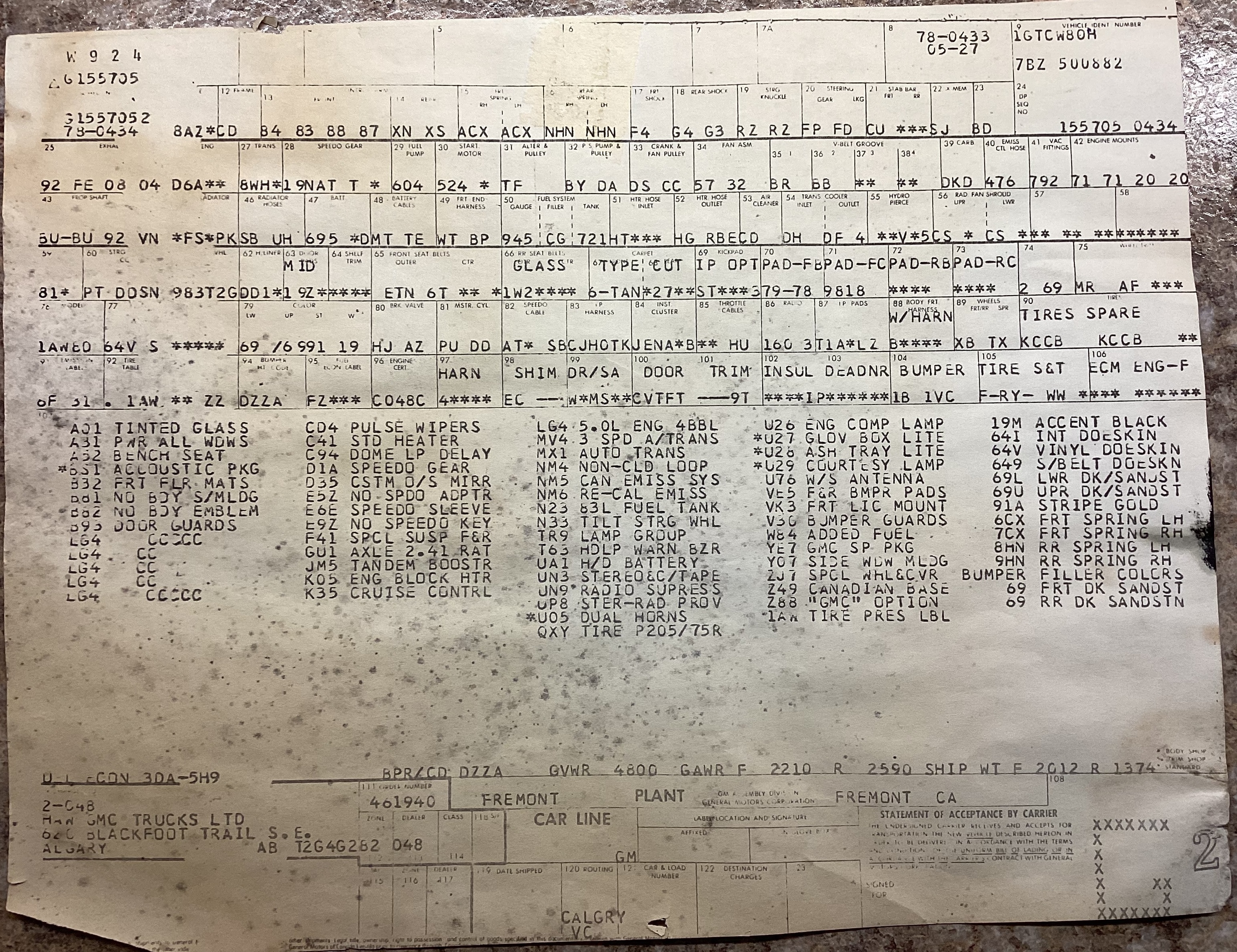The fifth generation El Camino started production in 1978, adopting the new Malibu styling, suspension parts, and a one-inch longer wheelbase of 117 in. The front end sheet metal and doors (two door Malibus) were shared with the Malibu, although the window glass was different. The rear bumper was shared with the Malibu station wagon, although the tailgate was not, contrary to popular reporting. The station wagon tailgate is roughly the same but has differences like an exterior latch, and no upper indented character line. For the first time, though, the El Camino had a unique chassis shared with no other Chevrolet. The floorboard design is mostly shared with the wagon, up to the end of the cargo location. Rear air shocks were standard equipment so that the car-like ride would be preserved until hauling capability was needed, when the shocks could be aired up. The frame of the El Camino is not the same one used in the station wagon.
The Malibu sedan and station wagon ceased production after the 1983 model year, as well as their cousins in the other GM lines; Buick, Pontiac, and Oldsmobile. In 1985 GM shifted El Camino production to Mexico.
El Camino production ended in late 1987. Some model year 1987's (420 El Caminos and 325 GMC Caballeros) are listed as new car retail deliveries in calendar year 1988 based on their date of first retail sale. GM chose not to continue the El Camino platform for several reasons: a suitable rear-drive platform was not available at the time with GM's switch to mainly front-drive platforms, and GM claimed waning interest in the El Camino although sales charts do not back this up as sales were steady until GM announced the discontinuation of the platform.
The GMC version of the El Camino was virtually identical, except for a few small cosmetic and naming differences to rebadge the product as a GMC.
The El Camino was produced in plants located in: Baltimore, MD; Doraville, GA; Leeds, MO; Arlington, TX; Fremont, CA; Oshawa, Ontario, Canada, and Ramos Arizpe, Mexico.
From 1978 through 1981, The El Camino was technically still called an 'A' body by GM. It wasn't until 1982 that the 'G' body designation took effect officially. From 1978 to 1982, the model designation for the El Camino was AW80, and from 1982 to 1987 the model designation was GW80.
In the articles that follow, please note that any RPO (Regular Production Option) codes we list are confirmed to be appropriate by either GM paperwork or by individual build sheets. Obviously there may be some holes in this information but we are always updating this site and endeavoring to make our lists more complete.
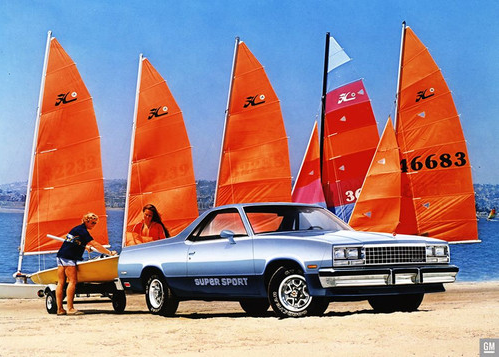
All years 1978-1987:
-Angle of approach: 20 degrees, .06 min.
-Angle of departure: 15 degrees, 15 min.
-Axle shaft: integral shaft and drive flange
-Body mounting: 7 each side of frame, 10 double cushion and 4 single cushion
-Brakes: Hydraulic, self-adjusting, power assisted, 10.5in. X 1.03in. front cast-iron vented disc, 9.5 in. x 2 in. rear cast-iron finned drum
-Brake master cylinder: dual resevoir (front/rear split)
-Brake booster: Delco two-diaphragm, 7.9in. X 7.9in. nominal diameter, vacuum/hydraulic
-Control arms: reinforced stamped steel with pre-loaded steel-encased rubber bushings at pivot
-Driveline type: tubular exposed, single, 2 Cardan universal joints with pre-packed anti-friction bearings
-Door beams: saftey guard
-Effective head room: 37.6 in.
-Electrical: 12v negative ground
-Exhuast: single aluminized
-Exterior paint type: acrylic lacquer
-Frame: Carbon steel, perimeter type, sigma-section rails, welded front and rear crossmembers with bolt-in tubular transmission support
-Front overhang: 36.0 in.
-Front shock absorbers: direct, double-acting hydraulic
-Front spindle: 3/4-20 UNEF 3-A modified
-Front suspension: independant; coil springs and 1" shock absorbers
-Front wheel bearings: taper roller, two per spindle, inner 1.25in, outer .8437-.8445in
-Fuel fill: left-hand fill, rectangular
-General suspension provisions, leveling: front stabilizer bar
-General suspension provisions, anti-dive control: front suspension geometry
-General suspension provisions, anti-squat control: rear suspension geometry
-Generator: 37 amp
-Height: 53.8 in.
-Height rocker panel front to ground: 8.9 in.
-Height rocker panel rear to ground: 9.9 in.
-Inner fenders: plastic
-Length: 201.6 in.
-Lowest ground clearance: rear shock absorber bracket
-Lugs: 7/16-20 UNF 2B on 4.75in. bolt circle diameter
-Minimum base weight: 3155 lb.
-Minimum running ground clearance: 5.8 in.
-Parking brake: pedal-operated, cable to rear wheels, 63.73 sq. in. facing contact per axle
-Ramp breakover angle: 13 degrees, 45 min.
-Rear axle: Salisbury-type, hypoid gearing
-Rear axle differential to ground: 6.3 in.
-Rear axle gearing: positraction available on all ratios (2.29, 2.41, 2.56, 2.73, 3.08), 7.5" ring gear pitch diameter
-Rear axle housing: 2.53 in. X 0.18 in. section diameter and thickness at spring seat
-Rear bumper to ground: 13.7 in.
-Rear overhang: 48.5 in.
-Rear suspension: hypoid; coil springs, 1 in. air boosted shock absorbers
-Rocker panels: open channel
-Roof: halo construction
-Seat cushions and backrests: formed polyfoam
-Shoulder room: 56.8 in
-Spare tire: full size standard
-Steering: manual recirculating ball, parallelogram linkage
-Steering knuckles: nodular iron with integral steering knuckle arm
-Tread width front: 58.5 in.
-Tread width rear: 57.8 in.
-Turning diameter outside front, curb to curb: 42.66 ft.
-Turning diameter outside front, wall to wall: 39.89 ft.
-Wheelbase: 117.1 in.
-Wheels: 5 lug, 14"x6"
-Width with doors closed: 71.9 in.
-Width with doors open: 157.6 in.
-Windshield pillars: energy absorbing air-gap construction
1978:
-Fuel tank: 17.5 gallon
-Battery: 2500w @ 0 deg F
1979:
-Fuel tank: 17.7 gallon
-Battery: 3200w @ 0 deg F
1980:
-Battery: 2500w @ 0 deg F
-Fuel tank: 17.7 gallon
1981:
-Fuel tank: 17.7 gallon
1982:
-Automatic transmissions had optional 3rd gear lock-up torque converter clutch
-Fuel tank: 17.7 gallon
1983:
-Diesel versions: Dual batteries, 63 amp alternator, TH350 transmission with ratios: 2.52/1.52/1/Rev 1.93 with 27 spline yoke
-Battery: (now rated in CCA), 355 Cold Cranking Amps at 0 degrees F.
-Fuel tank: 17.7 gallon, 22 gallon (not available with Diesel engine)
1984:
-Battery: 355 Cold Cranking Amps at 0 degrees F.
-Fuel tank: 17.7 gallon
1985:
-Battery: 630 Cold Cranking Amps at 0 degrees F.
-Fuel tank: 17.7 gallon
1986:
-Battery: 630 Cold Cranking Amps at 0 degrees F.
-Fuel tank: 17.4 gallon
1987:
-Battery: 630 Cold Cranking Amps at 0 degrees F.
-Fuel tank: 17.7 gallon
Notes: Although the nominal fuel tank size seems to vary somewhat from year to year, this is probably due to measuring error taken each year for production and EPA specifications. In reality the same base fuel tank was most likely used throughout production.
Cargo box specifications:
-Cargo weight rating: 800 lbs.
-Cargo box area: 35.5 cubic feet
-Maximum width: 59.1in.
-Maximum length: 79.1 in.
-Width between wheel wells: 45 in.
-Tailgate loading width: 53.1 in.
-Construction: double-walled, ribbed steel
-Liftover height: 25.2 in.
Paint and body process (from GM documentation):
1. RUSTPROOFING. Assembled car bodies are chemically sprayed to clean and etch the metal surfaces for corrossion resistance and paint adhesion. Unassembled sheet metal parts follow the same process.
2. BODY PRIMERS. Four corrosion resistant primers, specially formulated, are hand sprayed on the body in areas where rust might develop. Lower areas considered especially vulnerable are coated with another rust inhibiting compound.
3. SHEET METAL PRIMER is applied to all outside and inside surfaces of front fenders and hoods. The parts are mechanically dipped or flow-coated to insure coating in all seams and secluded areas, and baked at 390 degrees F. for 30 minutes. A coat of sealer is then applied by hand spray to all surfaces requiring lacquer.
4. FLASH PRIMER AND PRIMER SURFACER COATS. An air-dry flash primer caot is hand sprayed on surfaces below the body belt line. Then a gray primer-surfacer coat is hand sprayed on all outside surfaces of the body and ove baked for 45 minutes at 285 degrees F.
5. INITIAL SANDING. Power wet sanding, followed by hand sanding is done on all body surfaces requiring lacquering. This insures a smooth surface for the lacquer finish. To remove the water, the body is wiped and run through an infrared oven.
6. LACQUERING. Three coats of acrylic lacquer are applied on the exterior surfaces of the body and sheet metal parts to build up a finish of the required thickness and color.
7. INITIAL BAKING. To harden the paint for two tones, the body and sheet metal parts are baked for approximately 10 minutes at 200 degrees F.
8. FINAL BAKING. To assure a durable, hard, high luster finish the lacquer is baked for 30 minutes at 325 degrees F. Reheating the lacquer permits paint film to soften, allowing surface blemishes to disappear during the thermo-flow process.
9. UNDERCOATING. To block out road noise, an asbestos fiber sound deadener with asphalt base is sprayed inside the wheel housings and on the bottom of the underbody at designated areas.
10. PAINT REPAIR AND PROTECTION. Mars, nicks, or scratches that occur during final assembly are corrected at the factory before shipment. When required, light "slush" polishing brings painted surfaces to a high luster finish. Wax is applied to all horizontal surfaces of each vehicle and polished out for protection during shipment. The wax contains no silicones, thus eliminating any paint contamination problem.
Body glass:
-Windshield visibility area: 1253.0 sq. in.
-Front door window visibility area: 898.0 sq. in.
-Rear quarter window visibility area: 122.0 sq. in.
-Back window visibility area: 513.8 sq. in.
-Total sq area: 2787.0 sq. in.
-Backlight slope angle: 20.0 degrees
-Windshield slope angle: 58.5 degrees
-Tumble-home: 23.5 degrees
-Windshield type: curved laminated plate
-Side glass type: curved tempered plate
-Rear glass type: curved tempered plate
Vinyl roofs:
Dealer documentation specifies that at least for several years, vinyl roofs in various colors were available. For fifth generation El Caminos this seems to have been a rarely-ordered option as we have encountered few of these up to this date. If you have any verified photographs of 1978-1987 vinyl roofs, please send them to us so we can provide more evidence of actual production cars/colors!
The two RPO codes seem to be for the two types: CB7 for units without the midline chrome body trim, ZK9 for units with the chrome midline trim. With or without the trim line changes the transition from the vinyl top edge trim, as can be seen in the pictures below.
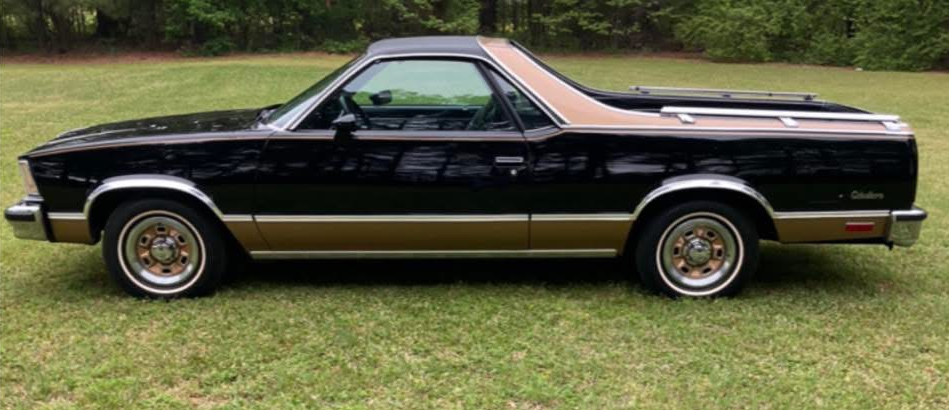
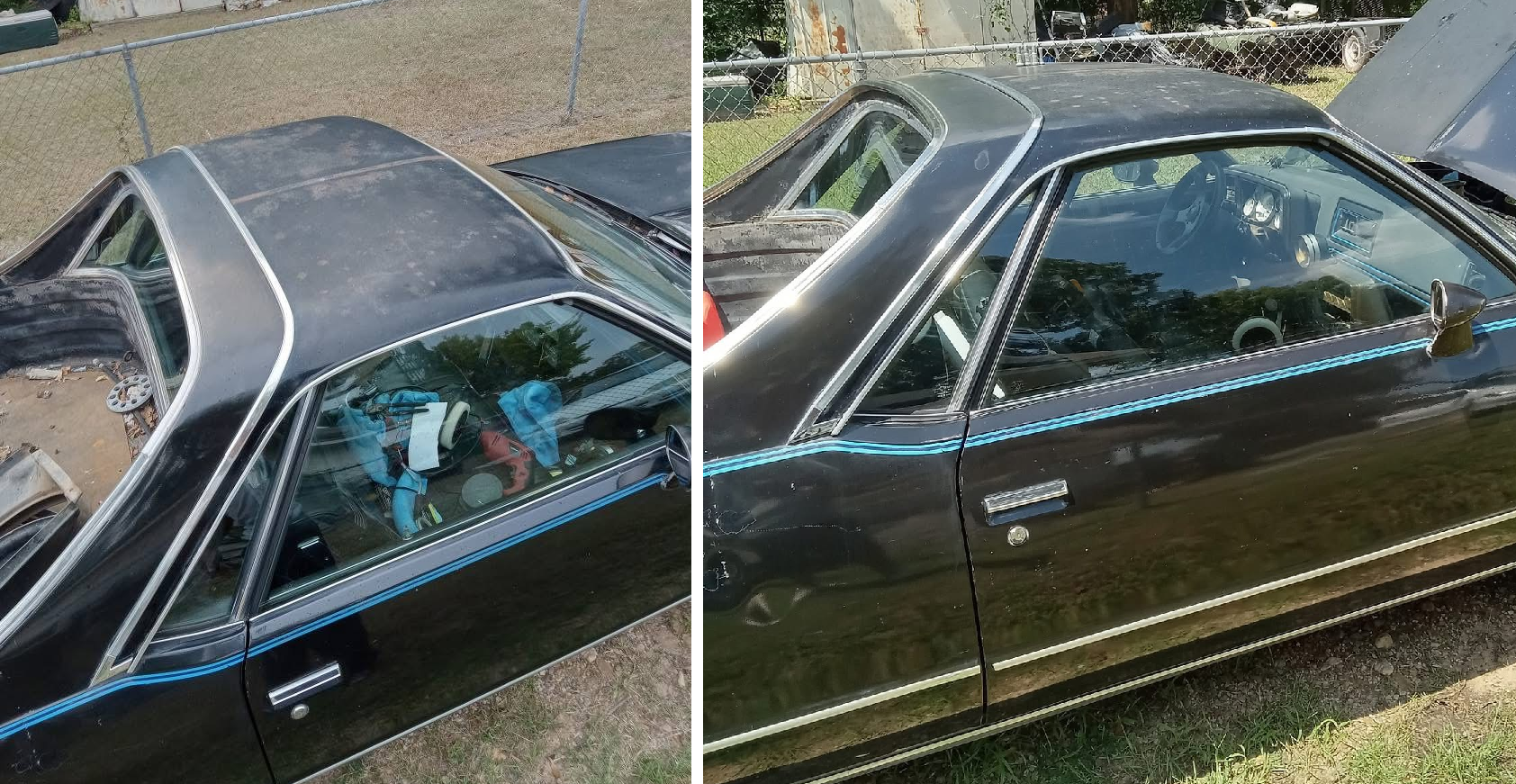
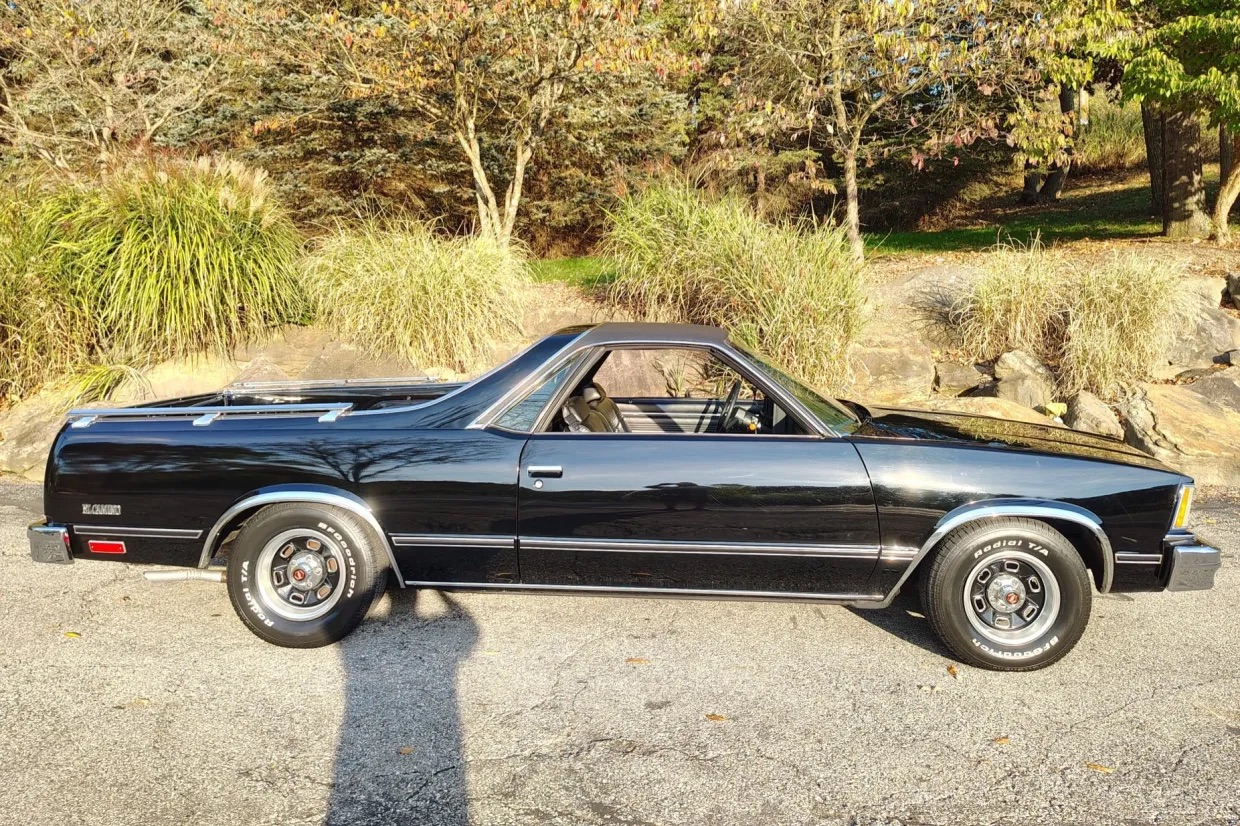
Thanks to reader Martin from the Czech Republic for the following photos of a vinyl top he located. We do not know if this full-coverage vinyl top was a factory option:
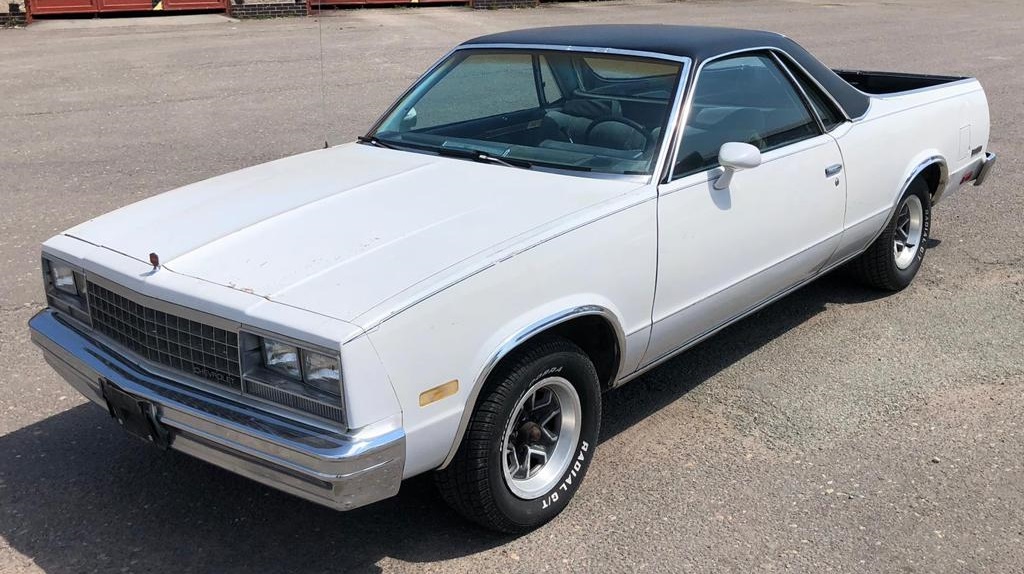
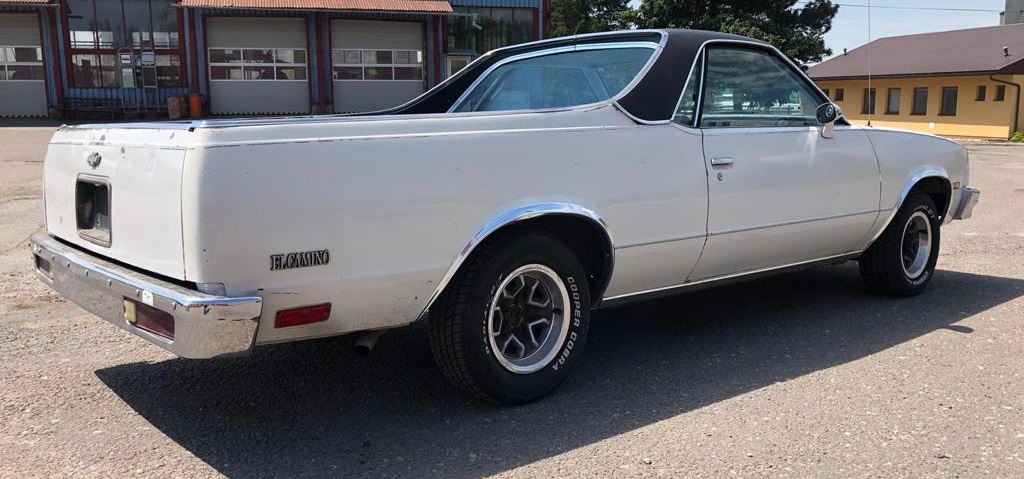
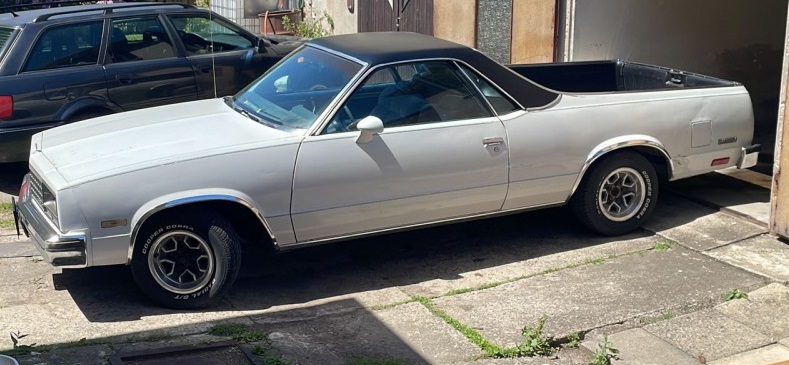
1978:
-One headlamp each side introduced. Chevrolet nameplate on chrome grille on upper driver's side, "Chevrolet" block letters outlined against a black background. One-year-only tail lamps with backup lights in outboard side.
1979:
-Restyled grille with finely graduated rectangular openings and a more pronounced vertical center bar, Chevrolet nameplate relocated to lower left portion of grille opening. New colors offered. Tail lamps redesigned by moving backup light to inboard position. 231 cubic inch Buick V6 eith "closed loop" emissions for California introduced. 267 cubic inch V8 RPO L39 introducted except in California. 305 cubic inch 4bbl RPO LG4 replaces 305 cubic inch 2bbl RPO LG3. RPO UN3 introduced, AM/FM radio with cassette. RPO UP5 introduced, CB AM/FM monoaural radio. RPO UP6 introduced, CB AM/FM stereo radio. RPO UY8 introduced, AM/FM stereo radio with clock and digital display. Instrument cluster bezel now color keyed. Light smoke gray beads used on instrument cluster face. Bright finish beads used on the radio/HVAC panel and optional floor console.
1980:
-Hood ornament introduced, emblem moved from upper grille center to ornament on grille header panel. Grille changed to vertical bar style. Front fenders received marker lights starting this year.
1981:
-Restyled grille with horizontal bars. All gas engines get Computer Command Control (CCC). Restyled Instrument panel pad, international symbols on controls, model nameplates on dash pad. Doors now get pull straps. Standard full wheelcovers have new diamond pattern.
1982:
-Restyled grille with 'crosshatch' design. Headlights changed to quad style. "Silver Gray" interior color available for first time.
1983:
-Diesel engine from Oldsmobile first offered in El Caminos.
1984:
-Last year for Diesel engine from Oldsmobile in El Caminos.
1985:
-New full wheelcover design for base models. New 4.3 Fuel Injection engine and nameplate on tailgate. New halogen high and low beam headlamps. 305 cubic inch engines now receive Electronic Spark Control (ESC). 4-speed automatic transmission available.
1986:
-Steering wheel change to 'flat' spoke design with outboard horn buttons.
1987:
-1986 and 1987 vehicles were virtually the same design, even according to documentation GM sent to dealers.
Style differences in bench seat designs. Note that of course colors and materials always varied:
Style differences in steering wheel designs. Note that color always varied, and 78-85 wheels had a trim ring around the wheel perimeter as well as a different horn button:
Style differences in shifter designs:
Style differences in gauge clusters:
-1978, 1979, 1980, 1981 had base linear speedometers, fuel gauge, and dummy lights. The UF7 option gave round gauges with a clock. The Z53 option gave all gauges with tachometer, but no clock. The U14 option gave round gauges with a tachometer and nested clock. Note that from 1980 onward the '55' in MPH was red-highlighted.
-1982, 1983, 1984, 1985 clusters had a base cluster with round gauges, however only speedometer and fuel; the rest were dummy lights. The upgraded options were the same as previous years.
-1986, 1987 clusters had a newer font. The base cluster had speedometer and fuel gauge. U39 added temperature, voltage, and oil pressure gauges, U35 placed a clock on the right (with the clock font unchanged), U16 placed a tachometer there. In '86 and '87 both clock and tachometer could NOT be ordered simultaneously.
1978:
-200 cubic inch 2bbl Chevrolet V6 rated at 95 hp @ 3800 RPM and 160 lb-ft @ 2000 RPM (base engine)
-231 cubic inch 2bbl Buick V6 rated at 105 hp @ 3400 RPM and 185 lb-ft @ 2000 RPM(California base engine)
-305 cubic inch 2bbl V8 rated at 145 hp @ 3800 RPM and 245 lb-ft @ 2400 RPM
-305 cubic inch 2bbl V8 rated at 135 hp @ 3800 RPM and 240 lb-ft @ 2000 RPM (California only)
-350 cubic inch 4bbl V8 rated at 170 hp @ 3800 RPM and 270 lb-ft @ 2400 RPM (El camino, station wagons, and 9C1 package only)
-350 cubic inch 4bbl V8 rated at 160 hp @ 3800 RPM and 260 lb-ft @ 2400 RPM (California only, El camino, station wagons, and 9C1 package only)
1979:
-200 cubic inch 2bbl Chevrolet V6 rated at 94 hp @ 4000 RPM and 154 lb-ft @ 2000 RPM (base engine)
-231 cubic inch 2bbl Buick V6 rated at 115 hp @ 3800 RPM and 190 lb-ft @ 2000 RPM (California base engine)
-267 cubic inch 2bbl V8 rated at 125 hp @ 3800 RPM and 215 lb-ft @ 2400 RPM
-305 cubic inch 4bbl V8 rated at 160 hp @ 4000 RPM and 235 lb-ft @ 2400 RPM
-305 cubic inch 4bbl V8 rated at 155 hp @ 4000 RPM and 225 lb-ft @ 2400 RPM (California only)
-350 cubic inch 4bbl V8 rated at 165 hp @ 3800 RPM and 260 lb-ft @ 2400 RPM (El camino, station wagons, and 9C1 package only)
1980:
-229 cubic inch 2bbl Chevrolet V6 rated at 115 hp @ 4000 RPM and 175 lb-ft @ 2000 RPM (base engine)
-231 cubic inch 2bbl Buick V6 rated at 110 hp @ 3800 RPM and 190 lb-ft @ 1600 RPM (California base engine)
-267 cubic inch 2bbl V8 rated at 120 hp @ 3600 RPM and 215 lb-ft @ 2000 RPM
-305 cubic inch 4bbl V8 rated at 155 hp @ 4000 RPM and 240 lb-ft @ 1600 RPM
-305 cubic inch 4bbl V8 rated at 155 hp @ 4000 RPM and 230 lb-ft @ 2400 RPM (California only)
-Note: this is the last year for a different 305 for California. After this all 305's were configured for the same output.
1981:
-229 cubic inch 2bbl Chevrolet V6 rated at 110 hp @ 4200 RPM and 170 lb-ft @ 2000 RPM (base engine)
-231 cubic inch 2bbl Buick V6 rated at 110 hp @ 3800 RPM and 190 lb-ft @ 1600 RPM (California base engine)
-267 cubic inch 2bbl V8 rated at 115 hp @ 4000 RPM and 200 lb-ft @ 2400 RPM
-305 cubic inch 4bbl V8 rated at 145 hp @ 3800 RPM and 240 lb-ft @ 2400 RPM (California AND non-California the same)
1982:
-229 cubic inch 2bbl Chevrolet V6 rated at 110 hp @ 4200 RPM and 170 lb-ft @ 2000 RPM (base engine)
-231 cubic inch 2bbl Buick V6 rated at 110 hp @ 3800 RPM and 190 lb-ft @ 1600 RPM (California base engine)
-267 cubic inch 2bbl V8 rated at 115 hp @ 4000 RPM and 205 lb-ft @ 2400 RPM
-305 cubic inch 4bbl V8 rated at 150 hp @ 3800 RPM and 240 lb-ft @ 2400 RPM (California AND non-California the same)
1983:
-229 cubic inch 2bbl Chevrolet V6 rated at 110 hp @ 4200 RPM and 190 lb-ft @ 1600 RPM (base engine)
-231 cubic inch 2bbl Buick V6 rated at 110 hp @ 3800 RPM and 190 lb-ft @ 1600 RPM (California base engine)
-305 cubic inch 4bbl V8 rated at 145 hp @ 4000 RPM and 240 lb-ft @ 1600 RPM (California AND non-California the same)
-350 cubic inch fuel injection Diesel V8 rated at 105 hp @3200 RPM and 200 lb-ft @ 1600 RPM (California AND non-California the same)
-Note: the 5.7-liter Diesel V8 was made by Oldsmobile, which was also offered in Chevrolet's full-size cars. The Diesel was an attempt at better fuel mileage with higher torque than a small engine, but developed a bad reliability record because GM released it too quickly with insufficient testing and too much cost-cutting. Unfortunately by the time latent issues were worked out, it had developed a bad reputation and it was too late.
1984:
-229 cubic inch 2bbl Chevrolet V6 rated at 110 hp @ 4000 RPM and 190 lb-ft @ 1600 RPM (base engine)
-231 cubic inch 2bbl Buick V6 rated at 110 hp @ 3800 RPM and 190 lb-ft @ 1600 RPM (California base engine)
-305 cubic inch 4bbl V8 rated at 150 hp @ 4000 RPM and 240 lb-ft @ 2400 RPM (California AND non-California the same)
-350 cubic inch fuel injection Diesel V8 rated at 105 hp @3200 RPM and 200 lb-ft @ 1600 RPM (no longer offered in California)
1985 and 1986:
-262 cubic inch fuel injection (TBI) V6 rated at 130 hp @ 3600 RPM and 210 lb-ft @ 2000 RPM (California AND non-California the same)
-305 cubic inch 4bbl V8 rated at 150 hp @ 4000 RPM and 240 lb-ft @ 2000 RPM (California AND non-California the same)
1987:
-262 cubic inch fuel injection (TBI) V6 rated at 145 hp @ 4200 RPM and 225 lb-ft @ 2000 RPM (California AND non-California the same)
-305 cubic inch 4bbl V8 rated at 150 hp @ 4000 RPM and 240 lb-ft @ 2000 RPM (California AND non-California the same)
-RPO -- Size and notes -- years observed
-L26 -- 3.3L (200 cubic inch) 2bbl V6 -- 1978, 1979
-L39 -- 4.4L (267 cubic inch) 2bbl V8 -- 1979, 1980, 1981, 1982
-LB4 -- 4.3L (262 cubic inch) TBI (Throttle Body Injection) V6 -- 1985, 1986, 1987
-LC3 -- 3.8L (229 cubic inch) 2bbl V6 -- 1980, 1981, 1982, 1983, 1984
-LC6 -- 3.8L (231 cubic inch) 2bbl V6 Buick -- 1979 (Note: engine rarely mentioned in docs, seems to be interim use for LD5)
-LD5 -- 3.8L (231 cubic inch) 2bbl V6 Buick -- 1978, 1980, 1981, 1982, 1983, 1984
-LF9 -- 5.7L (350 cubic inch) fuel injection V8 Diesel -- 1983, 1984 more information
-LG3 -- 5.0L (305 cubic inch) 2bbl V8 -- 1978
-LG4 -- 5.0L (305 cubic inch) 4bbl V8 -- 1979, 1980, 1981, 1982, 1983, 1984, 1985, 1986, 1987
-LM1 -- 5.7L (350 cubic inch) 4bbl V8 -- 1978, 1979
Note: According to Wards Automotive Yearbook 1979, 40.2% of 1978 El Caminos had 350 CID engines and 47.6% had 305 CID engines.
For two years, 1983 and 1984, the 350 cubic inch Oldsmobile Diesel was offered in the El Camino. According to Bernie Vascotto at GMHC (General Motors Heritage Center) using historical records in the archives, out of 22,429 El Caminos built in 1983, 571 were built with the LF9 Diesel option. In 1984 out of 22,244 El Caminos built, 98 were built with the LF9 Diesel.
For those questioning whether the Diesel option could be ordered on the SS trim level, several owners have come forward with probable evidence that the Diesel could indeed be ordered on the SS package.
Oldsmobile was given the passenger car Diesel development project, possibly because GM often let Olds introduce new technologies such as the Hydramatic transmission and front-wheel drive.
The Diesel had to be ordered with some very specific mechanical options, such as dual batteries and particular suspension. Since the SS was merely a trim option by those years, it is perfectly logical that the SS could be had easily with a Diesel.
Because of the very few of these built, and only being offered for two years, this is one of the rarer El Camino models available.
Much has been written about the history of these engines, but by the time these were put in El Caminos the engine was in its last years. These engines have a much better reputation than their earlier brethren with many, if not all, of the issues being resolved by that time.
The LF9 Diesel engine was the only passenger-car V-8 diesel in the world at that time; engineered by Oldsmobile. Today it is remembered as a converted gas engine, but that is not the case. While manufacturing efficiencies dictated it share some things like head-bolt locations and other machining points with gas engines, the block was a unique high-nickel-content iron casting. It had larger bulkhead and main-bearing sections also.
The compression ratio was 22.5:1. The crankshaft was nodular iron, and although the connecting rods started as 403 gas-engine pieces, they had beefier ends and rods, and were a different length. Pistons were made from special high-strength cast aluminum by Bohn. The engine used glow plugs on a timer system, and a 10hp starter motor. 1981 added a roller cam and lifters, so all El Caminos would have had these.
The engine used mechanical fuel injection by the Roosamaster division of Stanadyne Corporation. The engines redline was 4,000 RPM. These engines were not NVH (noise, vibration, and harshness) suitable for passenger vehicles even though GM added an extra layer of sound deadening on the firewall in many of these vehicles. They are not quiet like modern passenger car Diesels, and sound like a large truck engine.
Although very low horsepower, they had respectable torque numbers. Acceleration was not great, and the engine is always panned for this. They did get great fuel mileage though, reported to be on average in mid to high 20 MPG in some cases. The Diesel was pretty much dropped into the GM model line-up with very few transmission or gearing adjustments. Without these changes, the resulting performance could never match a gas engine.
One problem that developed were broken or stretched head bolts resulting in blown head gaskets. They had 10 TTY (torque-to-yield) head bolts on each side, shared with the gas engines. Being TTY, they could not be reused and it is reported that some mechanics did not know this, causing issues later. It is also generally accepted that these 10 bolts were not enough for the high compression ratio, resulting in a lack of longevity and premature failure.
Another issue was the chain on the mechanical fuel-injector pump stretching with normal use causing late fuel delivery. Since Diesel engines rely considerably on fuel delivery timing, this was a big issue and not necessarily easily diagnosed.
Additionally there was the problem of car owners not being familiar with Diesel engine requirements, and using the wrong engine oil. This resulted in bearing failures and other lubrication-related problems.
A larger issue was that a water separator was not included on the early fuel systems, causing corrosion issues inside the fuel system. To counteract this some owners added drygas (anhydrous alcohol) to the fuel, but the alcohol reacted with the governor rings inside the injection pump causing the rings to flake off in chunks and block the fuel lines.
Reportedly dealership mechanics were inadequately educated on these engines, compounding and amplifying all these issues.
The 1981-up engines with DX blocks were improved in many areas, including water filtration and a roller cam as well as other small details. All of the Diesel engines used in EL Caminos would have had the improved engines.
The Oldsmobile Diesel was discontinued in 1985 with more than a million units sold overall, but it was already discontinued in the El Camino line after 1984.
The following is an example list of known VIN's for existing diesel El Camino platforms (if you have more please let us know):
1GCCW80N5DR154145 -- 1983 El Camino
1GCCW80N2DR110300 -- 1983 El Camino
-RPO -- ratio -- ring gear diameter in inches -- [possible axle stamp] -- years available
-GH2 -- 2.29 -- 7.5 -- [open: 2AH, 8AH, 2AT, 2RA] [locking: 2BH, 8BH, 2BT] -- (only with diesel option 1983, 1984)
-GM8 -- 2.56 -- 7.5 -- [open: 2AA ,2AY,2RY,2RC,8AY] [locking: 2BA, 2BY,2SY,2SC,8BY] -- 1979, 1980, 1981, 1982, 1986, 1987
-GU1 -- 2.41 -- 7.5 -- [open: 2AJ,2AZ, 6AJ, 8AJ, 8AZ] [locking: 2BJ,2BZ, 6BJ, 8BJ, 8BZ] -- 1978, 1979, 1980, 1981, 1982, 1983, 1984, 1985, 1986, 1987
-GU2 -- 2.73 -- 7.5 -- [open: 2AB,2AX ,2AL,6AB,8AB,2RD,8AX,2RX] [locking: 2BB,2BX,2BL,6BB,8BB,2SD,8BX] -- 1978, 1979, 1980, 1981, 1982, 1983, 1984, 1985, 1986, 1987
-GU4 -- 3.08 -- 7.5 -- [open: 2AC,2AV,6AC,8AC,8AV] [locking: 2BC,2BV,6BC,8BC] -- 1979, 1980, 1981, 1983, 1984, 1986, 1987
-RPO -- description
-G80 -- Positraction limited slip differential
-G84 -- High altitude ratio, only available with NA6 emissions and LC3 engine, 1982, 1983
-G92 -- Performance ratio option
Notes:
1) Axle stamp codes are stamped on front side of axle on passenger side of differential). Not all codes are verifed on 5th generation El Caminos. The codes summarized in this table were copied from two sources believed to be reliable but could not be verified from referenceable sources such as GM archives.
2) The G92 and G84 options were only available in certain powertrain combinations, and only specified a numerically higher axle ratio that was already a stand-alone option. Most likely used for easier standard package specification by GM.
4) For details about which engines and transmissions were available with which axles, see Powertrain combinations.
Note: specific 3-speed automatic transmission type for RPO MX1 assignment seems to have depended on axle ratio selected. In early years GM seems to have switched and swapped transmissions as necessary to obtain the total torque multiplication desired, rather than re-gear transmissions for individual applications.
Note: not all the RPO codes listed here may necessarily apply to the El Camino, but all apply to 'A' and 'G' bodies 1978-1987.
-RPO -- description
-D1A -- Speedometer Gear
-D1D -- Speedometer Gear
-E5Z -- No Speedometer Adapter
-E6E -- Speedometer Sleeve
-E9Z -- Less (no) Speedometer Key
-M15 -- 3-speed manual, (1) 3.50, (2) 1.89, (3) 1, (R) 3.62
-M20 -- 4-speed manual, (1) 2.85, (2) 2.02, (3) 1.35, (4) 1, (R) 2.85 [most likely Saginaw]
-M20 -- 4-speed manual, (1) 3.11, (2) 2.20, (3) 1.47, (4) 1, (R) 3.11 (used with 3.08 axle and 4.4L engine)[most likely Saginaw]
-M24 -- 4-speed manual [most likely Borg-Warner]
-M29 -- THM200, 3-speed automatic, (1) 2.74, (2) 1.57, (3) 1, (R) 2.07
-M31 -- THM250C, 3-speed automatic, (1) 2.52, (2) 1.52, (3) 1, (R) 1.93
-M33 -- THM350, 3-speed automatic, (1) 2.52, (2) 1.52, (3) 1, (R) 1.93
-M38 -- THM350, 3-speed automatic, (1) 2.52, (2) 1.52, (3) 1, (R) 1.93
-M64 -- 3-speed manual, (1) 3.50, (2) 1.89, (3) 1, (R) 3.62 [most likely Saginaw]
-M67 -- 4-speed manual, (1) 2.85, (2) 2.02, (3) 1.35, (4) 1, (R) 2.85 [most likely Saginaw]
-MD8 -- THM700R4, 4-speed automatic with overdrive, (1) 3.06, (2) 1.63, (3) 1, (4) 0.70 (R) 2.90
-MM3 -- specifies 3-speed manual option, non-specific type
-MM4 -- specifies 4-speed manual option, non-specific type
-MV4 -- THM350C, 3-speed automatic, (1) 2.52, (2) 1.52, (3) 1, (R) 1.93
-MV9 -- THM200C, 3-speed automatic, (1) 2.74, (2) 1.57, (3) 1, (R) 2.07
-MW9 -- THM2004R, 4-speed automatic with overdrive, (1) 2.78, (2) 1.57, (3) 1, (4) 0.67, (R) 2.07
-MX1 -- specifies 3-speed automatic option, non-specific type
-MX0 -- specifies 4-speed automatic option, non-specific type
-MX2 -- THM350C, 3-speed automatic
Note: for an RPO cross-reference, see here
-RPO -- Engine uses
1978:
-M15 -- 200
-M20 -- 305
-M29 -- 200, 231, 305
-M33 -- 231
-M38 -- 200, 305, 350
1979:
-M15 -- 200
-M20 -- 267, 305
-M29 -- 200, 231, 305
-M38 -- 267, 350
1980:
-M15 -- 229
-M20 -- 305
-M31 -- 305
-M33 -- 231, 305
-M38 -- 267, 305
-MV4 -- 305
-MV9 -- 229
1981:
-M24 -- 305
-M31 -- 229, 231, 267, 305
-M33 -- 267, 305
-M38 -- 229
-M64 -- 229
-M67 -- 305
-MV4 -- 267, 305
-MV9 -- 229, 231, 267, 305
-MW9 -- 305
-MX2 -- 231
1982:
-M31 -- 229, 267, 305
-MD8 -- 305
-MV4 -- 229, 267, 305
-MW9 -- 267, 305
-Note: No 231 V6 option listed, but was available in dealer paperwork. 1982 Buick 231 California emissions got MX2 or M31.
-Note: Overdrive transmissions listed here, although not shown as available in dealer paperwork.
1983:
-M31 -- 229, 231, 305
-MD8 -- 305
-MW9 -- 229, 305, 350 Diesel
-MX2 -- 231, 305, 350 Diesel
-Note: Overdrive transmissions listed here, although not shown as available in dealer paperwork.
1984:
-M31 -- 229, 305
-MD8 -- 305
-MV4 -- 305
-MV9 -- 231, 350 Diesel
-MW9 -- 229, 231, 305, 350 Diesel
-Note: Overdrive transmissions listed here, although not shown as available in dealer paperwork.
1985:
-MD8 -- 262, 305
-MV9 -- 231, 305, 262
-MW9 -- 262, 305
1986:
-MD8 -- 262, 305
-MV9 -- 231, 262, 305
-MW9 -- 262, 305
1987:
-MD8 -- 305
-MV9 -- 231, 305
-MW9 -- 305
-Note: No 262 V6 option listed, but was available in dealer paperwork.
-Note: Some documents show the MV9 was not available on the 305, other documents show it was available; however actual SPID labels show this combination was made.
-RPO -- description -- years observed
-1AW -- Tire Pressure Label -- 1978, 1979, 1981
-55P -- Wheel trim: Wheel Covers, Sport (Gold) -- 1978, 1979, 1980, 1981, 1982
-N95 -- Wheel trim: Wheel Covers, Wire -- 1978, 1979, 1980, 1981, 1982, 1983, 1984, 1985
-N91 -- Wheel trim: Wheel Covers, Wire, With locks -- 1986, 1987
-N18 -- Wheel cover locking package, only with N95 wire wheels -- 1981, 1982, 1983, 1984, 1985
-P01 -- Wheel covers --
-PB2 -- Wheel trim: Wheel Covers, Sport (Silver, styled plastic) -- 1978, 1979, 1980, 1981, 1982, 1983
-QFK -- Tires: P205/75 R-14-B White Stripe (Radial) -- 1979
-QFT -- Tires: P205/75 R-14-B Blackwall (Radial) -- 1984, 1985, 1986, 1987
-QFV -- Tires: P205/75 R-14-B White Lettered (Radial) -- 1979
-QJR -- Tires: P205/75 R-14-B Whitewall (Radial) -- 1984, 1985, 1986, 1987
-QJY -- Tires: P205/75 R-14-B White Stripe (Radial) -- 1979, 1980
-QJZ -- Tires: P205/75 R-14-B Blackwall (Radial) -- 1979, 1980
-QKH -- Tires: P205/75 R-14-B Blackwall (Radial) -- 1978
-QKJ -- Tires: P205/75 R-14-B Whitewall (Radial) -- 1978
-QKK -- Tires: P205/75 R-14-B White Lettered (Radial) -- 1978
-QKL -- Tires: P205/75 R-14-B White Lettered (Radial) -- 1979, 1980
-QSA -- Tires: P205/75 R-14-B White Lettered (Radial) -- 1984, 1985, 1986, 1987
-QVT -- Tires: P205/75 R-14-B White Stripe (Radial) -- 1982, 1983
-QXX -- Tires: P205/75 R-14-B Blackwall (Radial) -- 1981, 1982, 1983
-QXY -- Tires: P205/75 R-14-B White Stripe (Radial) -- 1981
-QXZ -- Tires: P205/75 R-14-B White Lettered (Radial) -- 1981, 1982, 1983
-QYB -- Tires: P205/75 R-14-B Whitewall (Radial) -- 1981
-QYC -- Tires: P205/75 R-14-B White Lettered (Radial) -- 1981
-ZJ7 -- Wheels, Rally, 1978 and 1979 could be color-keyed (styled steel wheels, special hub caps and trim rings) -- 1978, 1979, 1980, 1981, 1982, 1983, 1984, 1985, 1986, 1987
Notes: Blackwall tires were the base option for El Caminos. Rally wheels were the 'rectangular' hole style in 1978 and 1979. 'Triangle' hole style rally wheels were used thereafter. Note that for all years, the El Camino received wider tires than the similar-bodied coupes, sedans, or wagons. Also the base El Camino tire is steel-belted whereas the base sedan, coupe, and wagon recieved glass-belted.
-RPO -- description -- years observed
-U58 -- AM/FM Stereo Radio -- 1978, 1979, 1980, 1981, 1982, 1983, 1984, 1985
-U63 -- AM Radio -- 1978, 1979, 1980, 1981, 1982, 1983, 1984, 1985, 1986, 1987
-U69 -- AM/FM Radio -- 1978, 1979, 1980, 1981, 1982, 1983, 1984, 1985
-U73 -- Fixed mast antenna -- 1982, 1983, 1984, 1985, 1986, 1987
-U75 -- Power antenna -- 1978, 1979, (1980 assumed), 1981, 1982
-U76 -- Windshield antenna -- 1978, 1979, 1980, 1981
-UK4 -- Electronically tuned AM/FM Stereo Radio with seek and scan -- 1986
-UL6 -- AM Radio with digital clock -- 1986, 1987
-UM1 -- AM Stereo Radio with stereo 8-track -- 1978, 1979, 1980
-UM2 -- AM/FM Stereo Radio with stereo 8-track -- 1978, 1979, 1980, 1981, 1982
-UM7 -- Electronically tuned AM/FM Stereo Radio with seek and scan and digital clock -- 1986, 1987
-UM6 -- Electronically tuned AM/FM Stereo Radio with seek and scan, stereo cassette tape and digital clock -- 1986, 1987
-UN3 -- AM/FM Stereo Radio with stereo cassette -- 1979, 1980, 1981, 1982, 1983, 1984, 1985
-UN9 -- Radio Supression -- 1978, 1979, 1980, 1981
-UP5 -- AM/FM/CB Radio with power antenna, only with UX6 -- 1979, 1980
-UP6 -- AM/FM/CB Radio with power antenna -- 1979, 1980, 1981
-UP7 -- Radio, provisions for monaural instrumentation -- 1979
-UP8 -- Stereo-Radio Provision -- 1981
-UX1 -- Electronically tuned AM/FM Stereo Radio with seek and scan, stereo cassette tape with search and repeat, graphic equalizer and digital clock -- 1986, 1987
-UX6 -- Dual front speakers, incl. with U58, UM1, UM2, UN3, UY8 -- 1978, 1979, 1980
-UY8 -- AM/FM Stereo Radio with digital clock display -- 1979, 1980
Notes: Windshield antenna was not available from 1982 onward, fixed mast antennas were used instead. Power antennas were not available after 1982.
Question: did dual front speakers become standard from 1981 onward? Please let us know if you have any supporting documentation either way.
-Note that for emissions purposes, it seems the El Camino was classified as a 'passenger car' not a 'light truck' as GM usually calls it. Any VECI labels that are of a relevant year for when cars were split from trucks will have 'passenger cars' on the label.
-RPO -- description -- years observed
-K19 -- Air System (air injection reaction system) -- 1982
-N23 -- Tank, Fuel: 22 gallons (83 L) -- 1978, 1981
-NA2 -- Emissions Systems: Standard Emission Equipment -- 1978
-NA5 -- Emissions Systems: Standard Emission Equipment
-NA6 -- Emissions Systems: High Altitude Emission Equipment -- 1978(only available for MX1 and LM1 combination), 1983(only available for LC3 and LF9 engines), 1984(only available for LF9 engine)
-NB1 -- Emissions Systems: Closed Loop System (CCC - Computer Command Control) -- 1982
-NB2 -- Emissions Systems: California Requirements
-NM4 -- Emissions Systems: Export, Canada, non-closed loop -- 1981
-NM5 -- Emissions Systems: Export, Canada -- 1981
-NM6 -- Emissions Systems: Export, Canada, recalibration -- 1981
-NM8 -- Emissions Systems: Export, Canada, leaded fuel
-VJ9 -- Emissions Systems: California emissions information label -- 1978
-YA7 -- California emissions test -- 1978
-YF5 -- Emissions Systems: California Requirements -- 1978
-YF6 -- California procopt -- 1978
List of engine compartment emissions code labels VECI (Vehicle Emissions Control Information):
--Please let us know if you have an emissions label photo you can share that is not listed below or in the label list!
-For pictures and vacuum routing diagrams by label code, see here.
-Note that these codes will indicate the correct diagram to use for vacuum hose routing in each application.
-RPO code -- Emissions Label code -- Engine size and details -- GM label part #
1978 Emissions:
-NA2 -- CD -- 200 cubic inch 2bbl Chevrolet V6 -- 472881
-YF5 -- XK -- 231 cubic inch 2bbl Buick V6 (California) -- 476358
-NA2 -- CW -- 305 cubic inch 2bbl V8 -- 472882
-YF5 -- DN -- 305 cubic inch 2bbl V8 (California) -- 472885
-NA2 -- DT -- 350 cubic inch 4bbl V8 -- 472888
-NA6 -- LM -- 350 cubic inch 4bbl V8 (high altitude) -- 476338
-YF5 -- DZ -- 350 cubic inch 4bbl V8 (California) -- 472893
1979 Emissions:
-NA5 -- LC -- 200 cubic inch 2bbl Chevrolet V6 auto trans -- 14006774
-NA5 -- C4 -- 200 cubic inch 2bbl Chevrolet V6 manual trans -- 14010222
-YF5 -- BV -- 231 cubic inch 2bbl Buick V6 (California) -- 25505238
-NA5 -- Y7 -- 267 cubic inch 2bbl V8 -- 14017733
-NA5 -- X9 -- 305 cubic inch V8 4bbl -- 14015552
-YF5 -- CF -- 305 cubic inch 4bbl V8 (California) -- 14006783
1980 Emissions:
-NA5 -- AB -- 229 cubic inch 2bbl auto trans -- 14020621
-NA5 -- ZR -- 229 cubic inch 2bbl manual trans -- 14021871
-YF5 -- KP -- 231 cubic inch 2bbl (California) auto trans -- 25506764
-NA5 -- AK -- 267 cubic inch 2bbl -- 14020622
-NA5 -- ZS -- 305 cubic inch 4bbl manual trans -- 14021872
-NA5 -- AM -- 305 cubic inch 4bbl auto trans -- 14020623
-YF5 -- 26 -- 305 cubic inch 4bbl V8 (California) -- 14023197
1981 Emissions:
-NA5 -- AWS -- 229 cubic inch 2bbl Chevrolet V6 auto trans -- 14037722 or 14047073 or 14047077
-NA5 -- AWT -- 229 cubic inch 2bbl Chevrolet V6 manual trans -- 14037723 or 14047074
-YF5 -- BAB -- 231 cubic inch 2bbl Buick V6 (California) -- 25508923
-NM5 -- JTA -- 231 cubic inch 2bbl Buick V6 (Canada) -- 25508929
-NM4 + NM5 + NM6 -- ??? -- 305 cubic inch 4bbl V8 auto trans (Canadian GMC Diablo) --
-NA5 -- ALJ -- 267 cubic inch 2bbl V8 -- 14031182
-NA5 -- ALM -- 305 cubic inch 4bbl V8 auto trans -- 14031184
-NA5 -- ALR -- 305 cubic inch 4bbl V8 manual trans -- 14031186
-YF5 -- ALU -- 305 cubic inch 4bbl V8 (California) -- 14031189
1982 Emissions:
-NA5 -- CJZ -- 229 cubic inch 2bbl Chevrolet V6 -- 14049982
-NA5 -- LAW -- 229 cubic inch 2bbl Chevrolet V6 -- 14063728
-NA5 -- LAX -- 229 cubic inch 2bbl Chevrolet V6 -- 14063729
-YF5 -- GAH -- 231 cubic inch 2bbl Buick V6 (California) -- 25512989
-NM4 -- NAA -- 231 cubic inch 2bbl Buick V6 (Canada) -- 25511249
-NM5 -- NAB -- 231 cubic inch 2bbl Buick V6 (Canada) -- 25513365
-NA5 -- CVH -- 267 cubic inch 2bbl V8 -- 14055193
-NA5 -- CLA -- 267 cubic inch 2bbl V8 -- 14048893
-NA5 -- LBN -- 267 cubic inch 2bbl V8 -- 14065520
-NM5 -- CCH -- 267 cubic inch 2bbl V8 -- 14044689
-NM5 -- LBF -- 267 cubic inch 2bbl V8 -- 14063743
-NA5 -- LBR -- 305 cubic inch 4bbl V8 -- 14065521
-NA5 -- LBS -- 305 cubic inch 4bbl V8 -- 14065522
-YF5 -- LAN -- 305 cubic inch 4bbl V8 (California) -- 14063721
-NM6 -- CCN -- 305 cubic inch 4bbl V8 (Canada) -- 14044693
-NA5 -- OYD -- 350 cubic inch fuel injection Diesel V8 -- 22517335
-Note: 350 Diesel emissions label exists for all G bodies, not necessarily on El Caminos
-Note: GM part number 14048894 used on federal emissions 305 on 250 Dual Bed Beaded Converter
1983 Emissions:
-NA5 -- ??? -- 229 cubic inch 2bbl Chevrolet V6 --
-YF5 -- BBB -- 231 cubic inch 2bbl Buick V6 (California) -- 25514319
-NM4 -- JBA -- 231 cubic inch 2bbl Buick V6 (Canada) -- 25514320
-NA5 -- DYT -- 305 cubic inch 4bbl V8 -- 14071149
-NA5 -- DTN -- 305 cubic inch 4bbl V8 -- 14065565
-YF5 -- DTR -- 305 cubic inch 4bbl V8 (California) -- 14065566
-YF5 -- DYU -- 305 cubic inch 4bbl V8 (California) -- 14071150
-NM5 -- DCB -- 305 cubic inch 4bbl V8 (Canada) -- 14065507
-NM5 or NM8 -- DCD -- 305 cubic inch 4bbl V8 (Canada) -- 14065509
-NA5 or YF5 or NA6 -- SAY -- 350 cubic inch fuel injection Diesel V8 -- 22518536
-YF5 -- DXC -- With VJ9 (California) El Camino specific, probably Diesel -- 14063736
1984 Emissions:
-NA5 -- ??? -- 229 cubic inch 2bbl Chevrolet V6
-NB2 -- NDM -- 231 cubic inch 2bbl Buick V6 (California) -- 25518312
-NM4 or NM8 -- NXL -- 231 cubic inch 2bbl Buick V6 (California) -- 25518314
-NA5 -- XJT -- 305 cubic inch 4bbl V8 -- 1407530
-NA5 -- XSF -- 305 cubic inch 4bbl V8 -- 1407579
-YF5 -- XSK -- 305 cubic inch 4bbl V8 (California)
-YF5 -- XJU -- 305 cubic inch 4bbl V8 (California)
-NA5 -- ??? -- 350 cubic inch fuel injection Diesel V8
-NA6 -- ??? -- 350 cubic inch fuel injection Diesel V8 (high altitude)
-YF5 -- DXC -- With VJ9 (California) El Camino specific, probably Diesel -- 14063736
1985 Emissions:
-NA5 -- UBC -- 262 cubic inch fuel injection (TBI) V6 -- 14086523
-NB2 -- ??? -- 262 cubic inch fuel injection (TBI) V6 (California)
-NB2 -- UBH -- 305 cubic inch 4bbl V8 (California) -- 14086526
-NA5 -- UNP -- 305 cubic inch 4bbl V8 -- 14086594
1986 Emissions:
-NA5 -- YKH -- 262 cubic inch fuel injection (TBI) V6 -- 14100955
-NB2 -- YKJ -- 262 cubic inch fuel injection (TBI) V6 (California) -- 14100956
-NA5 -- YCL -- 305 cubic inch 4bbl V8 -- 14100932
-NM8 -- YCT -- 305 cubic inch 4bbl V8 (Canada) -- 14100938
-NB2 -- YCP -- 305 cubic inch 4bbl V8 (California) -- 14100935
-NB2 -- YCY -- 305 cubic inch 4bbl V8 (California) -- 14100942
-NM5 -- ??? -- 305 cubic inch 4bbl V8 (Canada) -- 14086573
1987 Emissions:
-NA5 -- ZCP -- 262 cubic inch fuel injection (TBI) V6 -- 10051426
-NB2 -- ZCS -- 262 cubic inch fuel injection (TBI) V6 (California) -- 10051428
-NA5 -- ZDB -- 305 cubic inch 4bbl V8 -- 10051436
-NA5 -- ZCT -- 305 cubic inch 4bbl V8 -- 10051429
-NB2 -- ZCW -- 305 cubic inch 4bbl V8 (California) -- 10051431
-NB2 -- ZDD -- 305 cubic inch 4bbl V8 (California) -- 10051438
-NM5 -- ZCY -- 305 cubic inch 4bbl V8 (Canada) -- 10051433
-NM5 or NM8 -- ZDA -- 305 cubic inch 4bbl V8 (Canada) -- 10051435
-RPO -- description -- years observed
-199 -- Seat Belt, Black
-249 -- Seat Belt, Light Blue -- 1978
-24I -- Interior, Light Blue -- 1978
-24V -- Vinyl, Light Blue -- 1978
-24X -- Big 4, Light Blue
-27B -- CDD2 Blue Cloth Bucket -- 1985
-62D -- Cloth Camel -- 1978
-62I -- Interior, Camel -- 1978
-629 -- Seat Belt, Camel -- 1978
-62V -- Vinyl, Camel
-62X -- BIG 4 CAMEL -- 1978
-64I -- Interior, Doeskin -- 1981
-64V -- Vinyl, Doeskin -- 1981
-649 -- Seatbelts, Doeskin -- 1981
-A01 -- Glass, Soft-Ray Tinted: all windows -- 1978, 1979, 1980, 1981, 1982, 1983, 1984, 1985, 1986, 1987
-A31 -- Windows, Power -- 1978, (1979 assumed), 1980, 1981, 1982, 1983, 1984, 1985, 1986, 1987
-A42 -- Seat, Power: Six-way -- 1978
-A51 -- Bucket Seats
-A52 -- Bench Seat -- 1979, 1980, 1981
-A65 -- Split Front Seat -- 1982
-AG7 -- Seat, Power: Six-way -- 1978
-AG9 -- Seat, Power: Six-way only with 50/50 seat -- 1979, 1980, 1981
-AK1 -- Belts, Deluxe: color-keyed seat and shoulder -- 1978, 1979
-AU3 -- Door Lock System, Power -- 1978, 1979, 1980, 1981, 1982, 1983, 1984, 1985, 1986, 1987
-AV7 -- Front seat 50/50 -- 1978
-BS1 -- Body Insulation 'Acoustic' Package -- 1978, 1979, 1980, 1981
-B32 -- Floor Covering: Mats, Color-keyed Floor (front only) -- 1978, 1979, 1980, 1981, 1982, 1983, 1984, 1985, 1986, 1987
-D24 -- Container, Litter (passenger kick panel) -- 1978, 1979
-D34 -- Mirror: Visor Vanity -- 1978, 1979
-D55 -- Console (center console) -- 1978, 1979, 1980, 1981, 1982, 1983, 1984, 1985, 1986, 1987
-D64 -- Mirror: Visor Vanity, Illuminated -- 1978, 1979
-N33 -- Steering Wheel: Comfortilt (tilt wheel) -- 1978, 1979, 1980, 1981, 1982, 1983, 1984, 1985, 1986, 1987
-TR9 -- Lighting, Auxilliary (incl. headlamp buzzer T63, courtey and underhood lights) -- 1979, 1980, 1981, 1982, 1983, 1984, 1985, 1986, 1987
-UF7 -- Gage Package (incl. voltmeter, temperature, oil pressure gauges and U35 clock) -- 1978, 1979, 1980, 1981, 1982, 1983, 1984, 1985
-U14 -- Instrumentation: Special (upgraded gauge cluster, incl. Z53 gauges, incl. U35 clock) -- 1978, 1979, 1980, 1981, 1982, 1983, 1984, 1985
-U16 -- Tachometer -- 1986, 1987
-U35 -- Clock: Electric (in gauge cluster) -- 1978, 1979, 1980, 1981, 1982, 1983, 1984, 1985
-U39 -- Gage Package with trip odometer (incl. voltmeter, temperature and oil pressure gauges) -- 1986, 1987
-Z53 -- Tachometer, Voltmeter, Temperature, and Oil Pressure gauges (incl. in U14)
-ZJ9 -- Lighting, Auxilliary -- 1978
These options usually included with other packages and not necessary noted on build sheets individually:
-C94 -- Dome/Courtesy Lamp - Electronic Delay Switch/timer -- 1978, 1980
-T63 -- Headlight warning buzzer
-U26 -- Underhood lamp -- 1979, 1981
-U27 -- Glove compartment light -- 1979, 1981
-U28 -- Ash tray light -- 1979, 1981
-U29 -- Instrument Panel Courtesy Lamp -- 1979, 1981
Notes: The standard gauge cluster for early years with linear speedometer is not listed as an RPO. The UF7 option would give round gauges with clock, and U14 would give round gauges with clock and tachometer. There is some confusion on which gauge packages of which years included a trip odometer.
For 1981+, UF7 included standard trip odometer.
-RPO -- description -- years observed
-B3W -- Preliminary price information -- 1978, 1981, 1985
-D91 -- Conquista/El Camino Conquista or GMC Package (Laredo/Amarillo) --
-FRM -- Fremont Plant -- 1978
-V94 -- Export Tax --
-W84 -- Add Fuel, Gas -- 1979, 1980, 1981
-YE7 -- GMC Special Package (Diablo) -- 1981
-YH6 -- Bonus value option package -- 1985
-Z15 -- El Camino Super Sport/Super Sport/El Camino SS/SS Sport Decor --
-Z16 -- Black Knight/Royal Knight decor package --
-Z49 -- Canadian Base Package -- 1980, 1981
-Z88 -- "GMC" option -- 1981
-RPO -- description -- years observed
-C41 -- Standard Heater -- 1981
-C60 -- Air Conditioning -- 1978, 1979, 1980, 1981, 1982, 1983, 1984, 1985, 1986, 1987
-C94 -- Dome Lamp Delay -- 1981
-CD4 -- Windshield Wiper Equipment: Intermittent System (pulse wipers) -- 1978, 1979, 1980, 1981, 1982, 1983, 1984, 1985, 1986, 1987
-J50 -- Vacuum Power Brakes -- 1979
-JM5 -- Power HD Brakes, Tandem Booster -- 1978, 1979, 1980, 1981, 1982
-K05 -- Block Heater, 600w, 120v -- 1981, 1983, 1984, 1985, 1986, 1987
-K30 -- Speed Control: Cruise-Master -- 1978, 1979, 1980
-K34 -- Speed Control, Electronic: with resume speed -- 1984, 1985, 1986, 1987
-K35 -- Speed Control With Resume Speed: Automatic -- 1981, 1982, 1983
-K76 -- Generator: 61 Amp Delcotron -- 1978
-K77 -- Alternator: 55 Amp -- 1979, 1980
-K81 -- Generator: 63 Amp Delcotron -- 1979, 1980, 1981
-N41 -- Steering: Power -- 1978, 1979, 1980
-NY8 -- Steering: Power #800 -- 1979
-TT4 -- Headlamps, Halogen -- 1981, 1985, 1986, 1987
-TT5 -- Headlamps, Halogen -- 1982, 1983, 1984
-U05 -- Horns, Dual -- 1979, 1980, 1981
-UA1 -- Battery: Heavy Duty -- 1978, 1979, 1980, 1981, 1982, 1983, 1984, 1985, 1986, 1987
-V01 -- Radiator, Heavy Duty -- 1978, 1979
-V08 -- Cooling, Heavy Duty -- 1980, 1981, 1982, 1983, 1984, 1985, 1986, 1987
-V10 -- Cold Climate Package (only on Diesel, incl. UA1 and K05) -- 1983
Note: For 1981 and later, power steering became standard (N41). Cruise contol did not get 'resume' until 1981.
-RPO -- description -- years observed
-AV3 -- Tie-Downs, Cargo Box (inside the box) -- 1978, 1979, 1980, 1981, 1982, 1983, 1984, 1985, 1986, 1987
-BW2 -- Moldings: Body Side, Deluxe -- 1978, 1979, 1980, 1981, 1982, 1983, 1984, 1985, 1986, 1987
-BX8 -- Moldings: Front Fender, Body Side and Tailgate -- 1978, 1979, 1980, 1981, 1982, 1983, 1984, 1985, 1986, 1987
-B81 -- Moldings: No Body Side Moldings -- 1981
-B82 -- Moldings: No Body Emblem (used on GMC) -- 1981
-B93 -- Moldings: Door Edge Guard -- 1978, 1979, 1980, 1981, 1982, 1983, 1984, 1985, 1986, 1987
-B96 -- Moldings: Wheel Openings -- 1979, 1982
-CB7 -- Vinyl top, Front -- 1979
-D33 -- Mirror: Outside Rearview, LH Remote -- 1978, 1979, 1980, 1981, 1982, 1983
-D35 -- Mirrors: Sport, LH Remote and RH Manual -- 1978, 1979, 1980, 1981, 1982, 1983, 1984, 1985, 1986, 1987
-D60 -- Non Recommended Color Combination
-D68 -- Mirrors: Sport, Twin Remote -- 1978, 1979, 1980, 1981, 1987
-D73 -- Rails, Cargo Box Side -- 1978, 1979, 1980, 1981, 1982, 1983, 1984, 1985, 1986, 1987
-D84 -- Paint, custom two-tone -- 1981, 1982
-D85 -- Body pin striping -- 1982
-E86 -- Tonneau Cover -- 1978 (possibly used 76-83 only)
-VE5 -- Bumper Equipment: Bumper Rub Strips -- 1978, 1979, 1980, 1981, 1982, 1983, 1984, 1985, 1986, 1987
-V30 -- Bumper Equipment: Bumper and guards, front and rear -- 1978, 1979, 1980, 1981, 1982, 1983, 1984, 1985, 1986, 1987
-V3G -- Bumper Equipment: Bumper and guards, front and rear -- 1981
-Y07 -- Side window molding -- 1981
-VK3 -- Front License Plate Holder -- 1978, 1979, 1981
-YT9 -- FI/Body Parts -- 1978
-ZK9 -- Roof Cover, Conquista Vinyl -- 1978, 1979, 1980
-ZP2 -- Exterior/Interior override -- 1978
-11K -- Cover, Cargo Box Tonneau: White -- 1978, 1979, 1980, 1981, 1982
-19K -- Cover, Cargo Box Tonneau: Black -- 1978, 1979, 1980, 1981, 1982
-19Q -- Moldings: Black -- 1978, 1982
-22Q -- Moldings: Light Blue -- 1978
-44Q -- Moldings: Light Green -- 1978
-61Q -- Moldings: Light Camel -- 1978
-63M -- MID/BDY CAMEL -- 1978
-79Q -- Moldings: Dark Carmine -- 1978
-91A -- Stripe Gold (observed on Diablo) -- 1981
-94A -- Stripe Gold
Accent colors: [Note that not all year availability may be correct for all colors]
-Note: The color code numbers below are generally similar for the L codes (Secondary Colors or 'lower'), U (Primary Colors or 'upper'), and T (Top Colors or 'upper')
-11M -- Accent Color: White -- 1978, 1979, 1980, 1981, 1982, 1983
-12M -- Accent Color: Silver Metallic -- 1985, 1986, 1987
-15M -- Accent Color: Silver Metallic -- 1978, 1979, 1980, 1983, 1984, 1985(called Medium Gray Metallic), 1986(called Medium Gray Metallic), 1987(called Medium Gray Metallic)
-16M -- Accent Color: Gray Metallic -- 1978, 1981(called Siler Metallic), 1982(called Siler Metallic)
-17M -- Accent Color: Bright Silver Metallic -- 1984
-19M -- Accent Color: Black -- 1978, 1979, 1980, 1981, 1983, 1984, 1985, 1986, 1987
-21M -- Accent Color: Light Blue Metallic -- 1978, 1980, 1981, 1982
-22M -- Accent Color: Medium Blue Metallic -- 1978(called Light Blue Metallic), 1979(called Light Blue Metallic), 1981, 1983(called Light Blue Metallic), 1984(called Light Blue Metallic)
-25M -- Accent Color: Light Blue Metallic -- 1985, 1986, 1987
-27M -- Accent Color: Dark Blue Metallic -- 1983, 1984
-29M -- Accent Color: Dark Blue Metallic -- 1978, 1980, 1981, 1982
-31M -- Accent Color: Dark Blue Metallic -- 1985, 1986, 1987
-35M -- Accent Color: Cream -- 1981
-36M -- Accent Color: Champagne Metallic -- 1981
-42M -- Accent Color: Light Fern Metallic -- 1983, 1984
-43M -- Accent Color: Light Green Metallic -- 1985, 1986
-44M -- Accent Color: Dark Green Metallic -- 1978(called Light Green Metallic), 1979(called Medium Green Metallic), 1980
-45M -- Accent Color: Light Jade Metallic -- 1978(called Medium Green Metallic), 1981(called Light Jade Green Metallic), 1982
-46M -- Accent Color: Medium Green Metallic -- 1985
-47M -- Accent Color: Jade Green Metallic -- 1981
-48M -- Accent Color: Dark Fern Metallic -- 1983, 1984
-49M -- Accent Color: Dark Jade Metallic -- 1982
-50M -- Accent Color: Yellow -- 1980
-54M -- Accent Color: Yellow Beige -- 1979(called Light Yellow), 1986
-56M -- Accent Color: Gold Metallic -- 1978
-58M -- Accent Color: Light Brown Metallic -- 1985, 1986, 1987
-59M -- Accent Color: Cream Beige -- 1980(called Beige), 1983(called Beige), 1984(called Beige), 1985
-61M -- Accent Color: Beige -- 1978(called Light Camel), 1979
-62M -- Accent Color: Medium Brown Metallic -- 1983(called Light Brown Metallic), 1984(called Light Brown Metallic), 1985, 1986, 1987
-63M -- Accent Color: Beige -- 1978(called Camel Metallic), 1979(called Camel Metallic), 1980(called Light Camel Metallic), 1981, 1982
-67M -- Accent Color: Dark Brown Metallic -- 1978(called Saffron Metallic), 1979(called Saffron Metallic), 1983, 1984
-68M -- Accent Color: Light Brown Metallic -- 1981, 1982
-69M -- Accent Color: Medium Brown Metallic -- 1978(called Dark Camel Metallic), 1979(called Dark Brown Metallic), 1980(called Medium Camel Metallic), 1981(called Dark Sandstone)
-71M -- Accent Color: Maroon Metallic -- 1987
-72M -- Accent Color: Light Maroon Metallic -- 1981, 1982(called Light Redwood Metallic)
-73M -- Accent Color: Light Maroon Metallic -- 1983, 1984
-75M -- Accent Color: Claret Metallic -- 1980
-76M -- Accent Color: Dark Claret Metallic -- 1980
-77M -- Accent Color: Carmine Metallic -- 1978, 1979, 1980(called Cinnabar), 1981(called Maroon Metallic), 1982(called Redwood Metallic)
-78M -- Accent Color: Dark Maroon Metallic -- 1983(called Maroon Metallic), 1984
-79M -- Accent Color: Dark Carmine Metallic -- 1978, 1979, 1985(called Dark Maroon Metallic), 1986(called Dark Maroon Metallic), 1987(called Dark Maroon Metallic)
-80M -- Accent Color: Silver Gray -- 1982
-84M -- Accent Color: Charcoal Metallic -- 1982
-85M -- Accent Color: Gray -- 1980
Note: After 1980 the vinyl roof options seems to have been no longer offered. Vinyl roof color codes: CC=Light Camel Metallic, BB=Black, DD=Light Blue Metallic, RR=Dark Claret Metallic, GG=Dark Green Metallic, QQ=Gray, WW=White.
Note: the two seperate vinyl roof codes seem to be as follows: CB7 for units without the midline chrome body trim, ZK9 for units with the chrome midline trim. With or without the trim line changes the transition from the vinyl top edge trim.
-RPO -- description -- years observed
-6CX -- Front Spring LH
-6DY -- Front Spring LH -- 1978
-6FC -- Front Spring LH -- 1978
-7CX -- Front Spring RH
-7DY -- Front Spring RH -- 1978
-7FC -- Front Spring RH -- 1978
-8HK -- Rear Spring LH -- 1978
-8HN -- Rear Spring LH -- 1981
-8PZ -- Rear Spring LH -- 1978
-9HK -- Rear Spring RH -- 1978
-9HN -- Rear Spring RH -- 1981
-9PZ -- Rear Spring RH -- 1978
-F40 -- Suspension Equipment: Heavy duty front and rear -- 1978, (1979 assumed), 1980
-F41 -- Suspension Equipment: Sport -- 1978, 1979, 1980, 1981, 1982, 1983(not available on Diesel), 1984(not available on Diesel), 1985, 1986
Chassis:
1978 (2750 lb capacity all powertrain combinations, positraction rear available in all ratios):
-3-speed manual (200 V6), 2.73 rear axle ratio only, floor shift
-4-speed manual (305 V8), 2.73 rear axle ratio only, floor shift
-3-speed automatic (200 V6), 2.73 rear axle ratio only
-3-speed automatic (305 V8, 305 V8 California, 350 V8, 350 V8 California), 2.41 axle std., 2.73 optional
-3-speed automatic (231 V6 California), 2.73 rear axle ratio only
1979 (2750 lb capacity all powertrain combinations, positraction rear available in all ratios):
-3-speed manual (200 V6), 2.73 rear axle ratio only, floor shift
-4-speed manual (267 V8, 305 V8), 3.08 rear axle ratio only, floor shift
-3-speed automatic (200 V6), 2.73 rear axle ratio only
-3-speed automatic (267 V8), 2.56 rear axle ratio only
-3-speed automatic (305 V8, 305 V8 California, 350 V8), 2.41 axle std., 2.73 optional
-3-speed automatic (231 V6 California), 2.73 rear axle ratio only
1980 (2750 lb capacity all powertrain combinations, positraction rear available in all ratios only on non-California):
-3-speed manual (229 V6), 2.73 rear axle ratio only, floor shift
-4-speed manual (305 V8), 3.08 rear axle ratio only, floor shift
-3-speed automatic 200c (229 V6), 2.73 rear axle ratio only
-3-speed automatic th350 (267 V8), 2.56 rear axle ratio only
-3-speed automatic th250 OR 200c (305 V8), 2.41 axle std. [trans type dependent on production line choice]
-3-speed automatic th350 (305 V8), 2.73 optional axle
-3-speed automatic th350 (305 V8 California), 2.41 axle std., 2.73 optional
-3-speed automatic th350 (231 V6 California), 2.73 rear axle ratio only
1981 (2750 lb capacity all powertrain combinations, positraction rear available in all ratios EXCEPT where noted):
-3-speed manual (229 V6), 2.73 rear axle ratio only, floor shift
-4-speed manual (305 V8), 3.08 rear axle ratio only, floor shift, positraction NOT available
-3-speed automatic (229 V6), 2.73 rear axle ratio only
-3-speed automatic (267 V8), 2.56 rear axle ratio only
-3-speed automatic (305 V8, 305 V8 California), 2.41 axle std., 2.73 optional
-3-speed automatic (231 V6 California), 2.73 rear axle ratio only
1982: (2750 lb capacity all powertrain combinations, positraction rear available in all ratios):
-3-speed automatic (229 V6), 2.73 rear axle ratio only
-3-speed automatic (267 V8), 2.56 rear axle ratio only
-3-speed automatic (305 V8), 2.41 axle std., 2.73 optional
-3-speed automatic (231 V6 California), 2.73 rear axle ratio only
1983: (positraction rear available in all ratios):
-3-speed automatic (229 V6 NA5 emissions), 2.41 rear axle ratio only
-3-speed automatic (229 V6 NA6 emissions), 2.73 rear axle ratio only
-3-speed automatic (305 V8), 2.41 axle std., 3.08 optional
-3-speed automatic (350 V8 Diesel), 2.29 axle std,. 2.73 optional
-3-speed automatic (231 V6 California), 2.73 rear axle ratio only
1984: (positraction rear available in all ratios):
-3-speed automatic (229 V6), 2.41 axle std., 2.73 optional
-3-speed automatic (305 V8), 2.41 axle std., 3.08 optional
-3-speed automatic (350 V8 Diesel), 2.29 axle std,. 2.73 optional
-3-speed automatic (231 V6 California), 2.73 rear axle ratio only
1985: (positraction rear available in all ratios):
-3-speed automatic OR 4-speed automatic (262 V6), 2.41 axle std., 2.73 optional
-3-speed automatic OR 4-speed automatic (305 V8), 2.41 axle std., 2.73 optional
1986 and 1987: (positraction rear available in all ratios):
-3-speed automatic (262 V6), 2.41 axle std., 2.73 optional
-3-speed automatic (305 V8), 2.41 axle std., 2.73 optional
-4-speed automatic (262 V6), 2.56 axle std., 3.08 optional
-4-speed automatic (305 V8), 2.56 axle std., 3.08 optional
Trim levels Offered By Year:
1978:
-Chevrolet (1AW80): Classic, Conquista, Super Sport, Black Knight
-GMC (5AA00): Caballero, Laredo, Diablo
1979:
-Chevrolet (1AW80): El Camino, Conquista, El Camino SS, Royal Knight
-GMC (1AW80): Caballero, Laredo, Diablo
1980:
-Chevrolet (1AW80): Standard El Camino, Conquista, Super Sport, Royal Knight
-GMC (1AW80): Caballero, Laredo, Diablo
1981:
-Chevrolet (1AW80): Standard El Camino, Conquista, Super Sport, Royal Knight
-GMC (1AW80): Caballero, Amarillo, Diablo
1982-1983:
-Chevrolet (1GW80): El Camino, Conquista, Super Sport, Royal Knight
-GMC (1GW80): Caballero, Amarillo, Diablo
1984-1987:
-Chevrolet (1GW80): El Camino, Conquista, SS Sport Decor
-GMC (1GW80): Caballero, Amarillo, Diablo
Trim Level Details:
El Camino/El Camino Classic/Classic/Standard El Camino:
-Base trim level, one color paint.

Conquista/El Camino Conquista/RPO D91:
-Up-level trim with two-tone paint and more chrome, specifically a shoulder-line of chrome dividing the upper/lower colors.
El Camino Super Sport/Super Sport/El Camino SS/SS Sport Decor/RPO Z15:
-Up-level trim with SS badging and rally wheels. RPO (Regular Production Option) Z15.
Choo-Choo Customs conversion:
-El Camino SS was dealer-offered as a conversion from mid-1983 to end of production, completed by Choo-Choo Customs Inc., of Chattanooga, Tennessee to include the aerodynamic front end similar to the Monte Carlo SS (although a different molding since the El Camino is slightly narrower in the front), as well as other cosmetic customizations. For more details see here.
Black Knight/RPO Z16:
-RPO (Regular Production Option) Z16, also requires SS Z15. Special edition inspired package with a code 19 black painted car and caramel interior and added gold hood decal displaying two dragons flanking a Knight facing head on. The fenders had Black Knight done in florid Olde English script and repeated on the tailgate. Sport mirrors, rally wheels, and a front air dam. Production of the 1978 Black Knight was low; about 1,200 cars were made. A bulletin to dealers from Truck Merchandising Manager L.P. Schinzing specifies that both the Z16 Super Sport package and the Z15 Black Knight package must be specified on orders. Solid black paint, tri-tone gold pin striping on sides and tailgate, "Black Knight" lettered decals on lower front fender and lower right hand portion of tailgate. All exterior SS designation is eliminated (EL Camino SS nameplate on instrument panel is retained). Black side window reveal moldings, and gold graphic decal on hood. Gold rally wheels. Options not available on Black Knight: Body side moldings (BW2), Conquista decor eqip (D91), Wire wheel trim covers (N95), Silver sport wheel covers (PB2).
Royal Knight/RPO Z16:
-RPO (Regular Production Option) Z16, also requires SS Z15. Continuation of the Black Knight package but renamed due to litigation issues. GM ran the Black Knight for only one year because a lawsuit was launched against them for using the name. Sources do not mention who launched the suit but Marvel Comics had a Black Knight character with that script from 1955 and kept it going afterwards. In 1979 and onward, Chevrolet issued the package as Royal Knight. The Royal Knight was essentially an add on to the El Camino SS trim so all Royal Knights are, in effect, SS cars as well. They have two RPO codes on the build sheet and sales document. RPO Z15 for the SS package and Z16 for the Royal Knight package. 1979 had 2,815 Royal Knights produced. This package was released in paint colors besides black. A print ad shows a Royal Knight depicted in metallic silver with red hood logo. Decal details: large hood decal (dragons on shield), "Royal Knight" fender decals, one each side, "Royal Knight" tailgate decal, upper and lower body side stripes including: front fender, door, rear quarter panel and tailgate.
1979 Royal Knight color options:
-Exterior -- Decal -- Interior
-Beige -- Gold -- Camel
-Black -- Gold -- Black or Camel
-Black -- Blue -- Blue
-Black -- Red -- Carmine
-Blue, dark metallic -- Blue -- Black or Blue
-Blue, light metallic -- Blue -- Black or Blue
-Brown, dark metallic -- Gold -- Camel
-Camel, metallic -- Gold -- Black or Camel
-Carmine, dark metallic -- Red -- Black or Carmine
-Carmine, dark metallic -- Gold -- Camel
-Carmine, metallic -- Red -- Black or Carmine
-Silver, metallic -- Red -- Black or Carmine
-White -- Red -- Black or Carmine
-White -- Blue -- Blue
-White -- Gold -- Camel
1979 Royal Knight print ads:
1980 Royal Knight color options:
-Exterior -- Decal -- Interior
-Black -- Gold -- Black or Camel
-Black -- Blue -- Blue
-Black -- Red -- Claret
-Blue, dark metallic -- Blue -- Blue
-Blue, light metallic -- Blue -- Black or Blue
-Camel, light metallic -- Gold -- Camel
-Camel, medium metallic -- Gold -- Camel
-Cinnabar -- Red -- Black or Camel
-Claret, metallic -- Red -- Camel
-Claret, dark metallic -- Red -- Claret
-Claret, dark metallic -- Gold -- Camel
-Silver, metallic -- Red -- Black or Claret
-White -- Red -- Black or Claret
-White -- Blue -- Blue
-White -- Gold -- Camel
1980 Royal Knight print ads:
1981 Royal Knight color options:
-Exterior -- Decal -- Interior
-Black -- Gold -- Camel
-Black -- Red -- Maroon
-Blue, dark metallic -- Blue -- Dark Blue
-Blue, light metallic -- Blue -- Dark Blue
-Brown, light metallic -- Gold -- Camel
-Brown, medium metallic -- Gold -- Camel
-Maroon, metallic -- Gold -- Camel
-Maroon, metallic -- Red -- Maroon
-Maroon, light metallic -- Red -- Maroon
-Maroon, light metallic -- Gold -- Camel
-Silver, metallic -- Blue -- Dark Blue
-Silver, metallic -- Red -- Maroon
-White -- Red -- Maroon
-White -- Blue -- Dark Blue
-White -- Gold -- Camel
1982 Royal Knight color options:
-Exterior -- Decal -- Interior
-Blue, dark metallic -- Blue -- Dark Blue
-Blue, light metallic -- Blue -- Dark Blue
-Brown, light metallic -- Gold -- Camel
-Redwood, metallic -- Gold -- Camel or Redwood
-Silver Gray -- Red -- Silver Gray
-Silver, metallic -- Blue -- Dark Blue
-Silver, metallic -- Red -- Silver Gray
-White -- Red -- Redwood
-White -- Blue -- Dark Blue
-White -- Gold -- Camel
GMC Caballero/RPO Z88:
-Base package, similar to El Camino/Classic package.
GMC Laredo/Amarillo/RPO D91:
-Similar to Conquista.
GMC Diablo/Diablo Decor/RPO YE7:
-Similar to both the Royal Knight package and SS package, GMC offered the Diablo package for the Caballero. This continued even after the Royal Knight package was discontinued, making it more akin to the SS package overall.
Choo-Choo Customs conversions (dealer docs show pics in 1986 catalog under "SS Sport trim"). It appears to have officially been called the "El Camino SS".
The following is from GM approved Choo Choo Customs print ad (ad when shown in most sources in black and white is not very readable, so we have translated it here in text):
"The Original El Camino SS was produced by Choo Choo Customs for GM from mid-1983 until the El Camino series was discontinued at the end of 1987.
In addition to the aerodynamic nose treatment that was the primary styling feature of all El Camino SS, all vehicles received graphics on the fascia, doors, and tailgate, and a small chrome train logo above the glove compartment door.
Vehicles manufactured in 1987 also have the Choo Choo Customs logo with train on the front fascia and tailgate. A limited number of El Camino SS had aerodynamic ground effect style side exhausts with rectangular chrome exits.
Early El Camino SS until mid-1985 used aluminum body side molding with machine-turned center and two vinyl inserts running full length of the molding. Later El Camino SS used a more rounded style body side molding. Some vehicles used factory side molding and fender well trim.
Many El Camino SS were equipped with aluminum wheels. Early vehicles had center caps with styling holes. Later vehicles featured solid center caps.
Aluminum cargo rails were also installed in numerous vehicles.In 1986, Chevrolet was the offical truck of the Indianapolis 500 and a specially developed El Camino SS was one of the featured vehicles that performed on-track services before and throughout the race. This one only El Camino SS featured an aluminum 350 CID Chevy engine and functioning strobe headlights and tail lights, plus a roll bar mounted strobe light system.
A special El Camino SS was the only truck to ever pace an IROC race, This IROC-S also featured the trademark aerodynamic front end design, IROC urethane paint in custom candy colors, and 16" aluminum wheels. Approximately fifteen IROC-S were built between '85 and '86.
The same high quality GM approved components that made the original El Camino SS unique are available for restoration, customizing, and crash replacement.
These components are now available for enthusiasts who want to create an El Camino SS of their own. All of the El Camino SS products in this catalog are made on original tooling to exacting specifications and ...
The nose assembly and other components fit all El Caminos '78 through '87 and the popular Chevrolet Malibu '78 through '83.
Let us show you how to make your "Heartbeat" a little faster with genuine El Camino SS componets only from Choo Choo Customs.
Choo Choo Customs, Specialty Parts Division, 7801 Lee Highway, Chattanooga, TN 37421, 1-615-899-4473"
IROC-S print ad:
IROC-S, #15:
Where is the VECI label (Vehicle Emissions Control Information)?
What is the VECI label?

These are hard to come by in even a semi-readable form... thanks to all the sources that these pictures and photos come from.
--Please let us know if you have an emissions label photo you can share that is not listed below!
-For a reference of applications where each VECI (Vehicle Emissions Control Information) label applies, see here.
-Note that for emissions purposes, it seems the El Camino was classified as a 'passenger car' not a 'light truck' as GM usually calls it. Any VECI labels that are of a relevant year for when cars were split from trucks will have 'passenger cars' on the label.















Along with the A to G body name changeover in 1981, the VIN format changed as well. So there are two main VIN formats as described below.
1978-1980 El Camino VIN Breakdown:
Location – The VIN number is stamped on a plate located on top of the instrument panel and visible through the windshield on the drivers side. It is composed of 13 numbers and letters.
A sample 1978 El Camino VIN would look like this: 1W80L8R100001
1st digit – This is the manufacturers identity number
1 = Chevrolet
5 = GMC
2nd digit - This is the model series (A-Body)
W = El Camino
3rd and 4th and digits - This is the body style
80 = 2dr Sedan Pick-up
5th digit - This identifies the engine
A = V-6, 231cid
H = V-8, 305cid
J = V-8, 267cid
K = V-6, 229cid
L = V-8, 350cid
M = V-6, 200cid
U = V-8, 305cid
6th digit - This is the last digit of the model year
8 = 1978
9 = 1979
A = 1980
7th digit - This is the assembly plant code
B = Baltimore, MD
D = Doraville, GA
K = Leeds, MO
R = Arlington, TX (1979-1984 not GMC Caballero)
Z = Fremont, CA (1978-1981 Chevy and GMC)
1 = Oshawa, Canada
8th through 13th digits – Sequential Production Number
100001 – Sequential Production Number
1981-1987 El Camino VIN Breakdown:
Location – The VIN number is stamped on a plate located on top of the instrument panel and visible through the windshield on the drivers side. It is composed of 17 numbers and letters.
A sample 1981 El Camino VIN would look like this: 1GCCW80HXBR100001
1st digit - This is the country of origin
1 = U.S.A
2 = Canada
3 = Mexico
2nd digit – This is the manufacturers identity
G = General Motors
3rd digit - This is the make
C = Chevrolet Truck
T = GMC Truck
4th digit - This is the GVWR brake system
C = Hydraulic brake system - GVW 4001-5000
5th digit - This is the Series
W = El Camino/Caballero
6th and 7th digits - This is the body style
80 = 2dr Sedan Pick-up
8th digit - This identifies the engine
9 = V-6, 229cid
A = V-6, 231cid
H = V-8, 305cid
J = V-8, 267cid
K = V-6, 229cid
N = V-8, 350cid Diesel
Z = V-6, 262cid
9th digit -Check Digit
10th digit - This is the model year
B = 1981
C = 1982
D = 1983
E = 1984
F = 1985
G = 1986
H = 1987
11th digit - This is the assembly plant code
B = Baltimore, MD
D = Doraville, GA
K = Leeds, MO
R = Arlington, TX (1979-1984 not GMC Caballero)
Z = Fremont, CA (1978-1981 Chevy and GMC)
1 = Oshawa, Canada
S = Ramos Arizpe, Mexico (1985-1987 Chevy and GMC)
12th through 17th digits – Sequential Production Number
100001 – Sequential Production Number
Check digit info:
The 9th digit in the 17 digit VIN is called the check digit. The check digit is used to validate the VIN number. The check digit is calculated based on the other 16 alphanumeric values in the vehicle VIN.
The possible values for the check digit range from 1 through 9 and also include the letter X. Each position in the 17 digit VIN has a numerical value assigned to it. The 9th digit's position (check digit) has a value of 0, so it does not affect the calculation. Each alphanumeric character also has a numeric value. See the tables below for the numeric values for each character and position.
This is the formula used to calculate the check digit:
1. Multiply the numeric value of the first VIN position by the numeric value of the alphanumeric character present at that position and write the sum down on a piece of paper.
2. Repeat step 1 for all 17 VIN positions.
3. Add all 16 values obtained in steps 1 and 2 to get a total number value.
4. Divide the total number value obtained in step 3 by 11. Do not use a calculator; use long division. If the remainder of the division in step 4 is 10, use X as the check digit. Otherwise, use the remainder of the division (0 - 9) as the check digit.
Alphanumeric Character - Numeric Values
A-1
B-2
C-3
D-4
E-5
F-6
G-7
H-8
J-1
K-2
L-3
M-4
N-5
P-7
R-9
S-2
T-3
U-4
V-5
W-6
X-7
Y-8
Z-9
1-1
2-2
3-3
4-4
5-5
6-6
7-7
8-8
9-9
0-0
VIN Position - Numeric Values
1-8
2-7
3-6
4-5
5-4
6-3
7-2
8-10
9-0
10-9
11-8
12-7
13-6
14-5
15-4
16-3
17-2
Baltimore, MD -- Baltimore Assembly (properly named Broening Highway General Motors Plant) was a General Motors factory in Baltimore, Maryland. The plant opened in 1935 to produce Chevrolets and closed on May 13, 2005. It was a two-level plant located near the harbor and railroad lines in Baltimore.
Doraville, GA -- Doraville Assembly was a General Motors automobile factory in Doraville, Georgia. The plant opened in 1947 and closed on 26 September 2008 as part of the company's cost-cutting measures.
Leeds, MO -- Leeds Assembly was a General Motors automobile factory in Leeds, Missouri (Kansas City). It was closed in 1988. The factory produced the A-bodies and J-bodies.
Arlington, TX -- Made El Caminos 1979-1984 (not the GMC Caballero), according to plant literature. Plant production began January 6, 1954.
Fremont, CA -- Fremont Assembly started making the new-bodied El Caminos and GMC Caballeros in 1978. Fremont Assembly was a General Motors automobile factory in Fremont,California. It was the new site for production in the San Francisco area in 1962 with production moved from the older Oakland Assembly. Production continued through 1980 (supposedly into 1981) when the plant was closed.
Oshawa, Ontario, Canada -- Opened in 1953. Although some sources say El Caminos were made here, factory records only show Malibus from 1978-1980. No El Caminos are shown. If anyone has any records or El Caminos or Caballeros from this plant, please let us know.
Ramos Arizpe, Mexico -- Opened in 1981. In 1983, the GM Ramos Arizpe plant became the automaker’s first Mexican factory to export vehicles to the U.S. market, debuting with the Chevy El Camino. Some sources say 1985 was the first export date, but the data from GM specifying 1983 makes sense because they would have needed preperation and ramp-up time before all El Camino production moved here in 1985.
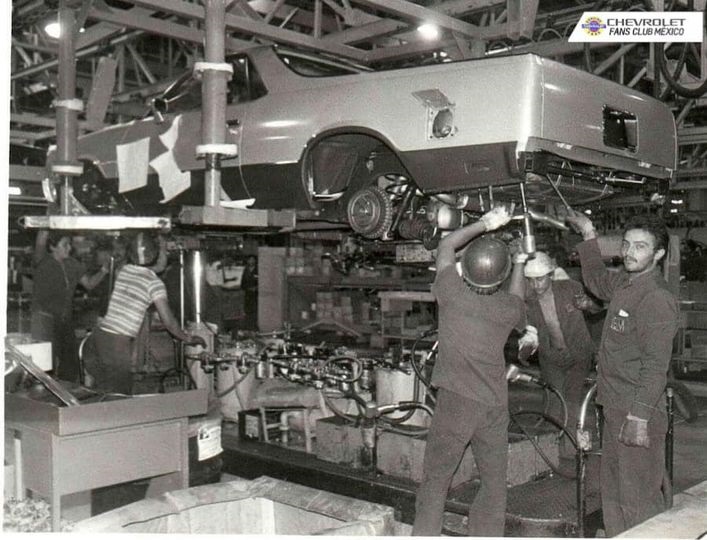
Here, El Caminos await rail transport loading at the Ramos Arizpe Mexico Production Plant:
To summarize what we have gleaned from various sources (please update us if you have conflicting information):
Starting in 1978, the El Camino and Caballero was made in Fremont, and starting in 1979 only the El Camino in Arlingtion. We cannot locate actual records of El Camino or Caballero production at Baltimore, Doraville, Leeds, or Oshawa at all.
In 1981 Fremont closed, then in 1984 Arlington discontimued El Camino production. In 1985 (and probably slightly before with some overlap) Ramos Arizpe took over all El Camino and Caballero production until the end in 1987.
This information leaves a significant gap in Caballero production from 1981-1985. We do not currently have any information to fill that gap, or the gaps in whether and how much the other plants contributed.
Note that all the numbers that follow have been located to the best of our ability. Descrepancies will always exist but we have done our best to locate the most accurate possible numbers.
El Camino sales numbers by year (total includes all trim levels and versions):
1978: 54,286-carsalesbase.com**
1979: 58,008-carsalesbase.com**
1980: 40,932-carsalesbase.com**
1981: 36,711-carsalesbase.com**
1982: 22,732-carsalesbase.com**
1983: 24,010-carsalesbase.com**
1984: 22,997-carsalesbase.com**
1985: 21,816-carsalesbase.com**
1986: 21,508-carsalesbase.com**
1987: 13,743-carsalesbase.com**
1988*: 420-carsalesbase.com**
*Some model year 1987's are listed as new car retail deliveries in calendar year 1988 based on their date of first retail sale. Note these are NOT '1988' models; there are no 1988 production models since this would require a VIN change after dealer delivery which cannot be done.
**source for carsalesbase.com is ANDC (Automotive News Data Center).
El Camino production* numbers by year (total includes all trim levels and versions):
1978: 54,286-GM Heritage Center
1979: 58,008-GM Heritage Center
1980: 40,932-GM Heritage Center (oldcarsweekly.com says 40,952)
1981: 37,533-GM Heritage Center (chevelles.com and elcaminos.com and thecowboycadillac.com** says 36,711)
1982: 23,104-GM Heritage Center (chevelles.com and elcaminos.com and thecowboycadillac.com** says 22,732)
1983: 24,429-GM Heritage Center (oldcarsweekly.com and elcaminocentral.com says 22,429) (chevelles.com and elcaminos.com and thecowboycadillac.com** says 24,010)
1984: 22,244-GM Heritage Center (oldcarsweekly.com and elcaminocentral.com says 24,244) (chevelles.com and elcaminos.com and thecowboycadillac.com** says 22,997)
1985: 24,582-GM Heritage Center (oldcarsweekly.com says 25,482) (chevelles.com and elcaminos.com and thecowboycadillac.com** says 21,816)
1986: 19,797-GM Heritage Center (oldcarsweekly.com says 16,229) (chevelles.com and elcaminos.com and thecowboycadillac.com** says 21,508)
1987: 15,589-GM Heritage Center (elcaminos.com and thecowboycadillac.com** says 13,743)
*Discrepancies could be due in part to different accounting methods; 'model year' versus 'actual year by date' as manufactured, and 'production' versus 'sales' numbers recorded in the incorrect category by researchers.
**The information from the cowboycadillac.com was obtained from the "Chevrolet El Camino Photo History" by automotive journalist Monty Montgomery.
Diesel production numbers by year (sub-breakdown of El Caminos):
1983: 571-GM Heritage Center
1984: 98-GM Heritage Center
SS, Z-15 RPO (sub-breakdown of El Caminos):
1978: 12,027
1979: 11,371
1980: 5,444
1981: 3,769
1982: 3,207
1983: 2,914 (one source says only 587)
1984: 1,309 (elcaminocentral.com says 4,144)*
1985: 1,198 (elcaminocentral.com says 4,710)*
1986: 996 (elcaminocentral.com says 4,692)*
1987: 861 (elcaminocentral.com says 3,967)*
*Note: it seems unlikely, though not impossible, that SS numbers would increase so drastically toward production end.
Caballero sales numbers by year (total includes all trim levels and versions independant from El Camino):
1978: 6,609-carsalesbase.com**
1979: 6,952-carsalesbase.com**
1980: 4,742-carsalesbase.com**
1981: 4,380-carsalesbase.com**
1982: 2,654-carsalesbase.com**
1983: 2,126-carsalesbase.com**
1984: 2,751-carsalesbase.com**
1985: 2,503-carsalesbase.com**
1986: 2,795-carsalesbase.com**
1987: 1,882-carsalesbase.com**
1988*: 328-carsalesbase.com**
*Some model year 1987's are listed as new car retail deliveries in calendar year 1988 based on their date of first retail sale. Note these are NOT '1988' models; there are no 1988 production models since this would require a VIN change after dealer delivery which cannot be done.
**source for carsalesbase.com is ANDC (Automotive News Data Center).
Caballero production** numbers (total includes all trim levels and versions independant from El Camino):
1978*: 6,609-elcaminos.com and thecowboycadillac.com***
1979: 6,952-elcaminos.com and thecowboycadillac.com*** (another source says 6,412)
1980: 4,742-elcaminos.com and thecowboycadillac.com*** (another source says 4,463)
1981: 4,380-elcaminos.com and thecowboycadillac.com*** (another source says 3,994)
1982: 2,654-elcaminos.com and thecowboycadillac.com*** (another source says 2,573)
1983: 2,126-elcaminos.com and thecowboycadillac.com*** (another source says 2,160)
1984: 2,751-elcaminos.com and thecowboycadillac.com*** (another source says 2,702)
1985: 2,503-elcaminos.com and thecowboycadillac.com*** (another source says 3,057)
1986: 2,795-elcaminos.com and thecowboycadillac.com*** (another source says 2,795)
1987: 1,882-elcaminos.com and thecowboycadillac.com***
*The [5AA00] designation of the GMC models in 1978 rather than 1AW80 probably accounts for confusion in data-gathering and lack of known numbers. See trim levels.
**Discrepancies could be due in part to different accounting methods; 'model year' versus 'actual year by date' as manufactured, and 'production' versus 'sales' numbers recorded in the incorrect category by researchers.
***The information from thecowboycadillac.com was obtained from the "Chevrolet El Camino Photo History" by automotive journalist Monty Montgomery.
Black Knight, Z15 + Z16 RPO's (sub-breakdown of El Caminos):
1978: 1,200 estimated by most sources (elcaminocentral.com says 2,814, another 2,815)*
*One researcher claims 9,213 Z15 (SS or Black Knight), 2,815 Z16 (Black Knight), but this would mean 6,398 SS since Black Knight had Z15 and Z16 which does not match SS data.
Royal Knight, Z15 + Z16 RPO's (sub-breakdown of El Caminos):
1979: 5,770-GM Heritage Center
1980: 2,598-GM Heritage Center
1981: 1,397-GM Heritage Center
1982: 899-GM Heritage Center
1983: none recorded-GM Heritage Center
Choo Choo Customs:
1983: 587-thecowboycadillac.com**
1984: 1,309-thecowboycadillac.com**
1985: 1,198-thecowboycadillac.com**
1986: 995-thecowboycadillac.com**
1987: 861-thecowboycadillac.com**
**The information from the cowboycadillac.com was obtained from the "Chevrolet El Camino Photo History" by automotive journalist Monty Montgomery.
Manual transmission quantities (sub-breakdown of El Caminos):
1978: 970 3-speed, 1,775 4-speed (elcaminocental.com)
1979: 2,043 3-speed, 1,771 4-speed (elcaminocental.com)
1980: 5,459 3-speed, 544 4-speed (elcaminocental.com)
1981: 3,020 3-speed, 637 4-speed (elcaminocental.com)
All of the keys for fifth generation El Caminos follow the same formats. Years before production of these cars started, GM had switched their keys to accomodate steering column ignition and steering wheel locks for security. These keys all have a square head on the ignition key and a rounded head on the door key.
There are eight possible blade profiles for these keys, and they are paired in sets of two, so there are four different factory blade profile combinations. These are designated by a letter A, B, C, D, E, H, J, or K. They are paired so that ignition and door keys have different letters in combinations of A and B, C and D, E and H, J and K. This letter is stamped into the blade of the key. The first letter in each pair designates the square head ignition key, and the second letter designates the round head key.
Because of these profile differences, keys might have the same cuts between letter designations but are impossible to insert into the wrong lock cylinders because the blade profile milling is different. Obviously due to age wear on both the keys and locks, this may allow exceptions to this. There are also some non-OEM replacement locks by companies such as Strattec that use a universal keyway and will accept all of the blanks. These were never used on factory GM vehicles and are only later replacement units.
These keys were punched out with dies at the factory by code for speed, not cut with a grinder wheel like aftermarket keys. The keys were stamped to the appropriate code and then later packaged with their appropriate locks for shipping to the assembly plant. Each specific cut combination was stamped into a knock-out section in the key ring hole, which could be retained by the owner for easy key replacement.
Since GM started in 1974 to dedicate just the square head key to the ignition, the round head key fits all the other locks and the square head is ignition only in these cars.
For these cars, the keys/locks are made by either Briggs and Stratton (the lock division of which is now Strattec), or Rochester Products (under license from Briggs and Stratton/Strattec). Each manufacturer has minute differences that an experienced eye can differentiate. Rochester Products keys are apparently stamped with the blank designation letter correctly oriented when the key is held with the blade parallel to the ground. The letter stamp on Briggs and Stratton was correctly oriented when the blade was held perpendicular to the ground. We have noticed that aftermarket blanks have angled stamps and other such changes so this most likely applies only to original factory keys. For the locks, if the spring cover is smooth lengthwise, it's a Rochester Products lock. Briggs and Stratton/Strattec have a slight crease lengthwise.
Complete sets of locks for a vehicle were not pre-packaged together. At the vehicle assembly plant (Fisher Body assembly plant in the case of the locks since they were body items), it was then possible that the ignotion locksets could come from one manufacturer and the door locksets from the other manufacturer. Since letter designations changed each year (or mostly each year), this seems to be the main reason to do this since otherwise the locks going in would have to first be sorted by the correct letter. With this assembly system all ignition locks for a certain year would have one letter, and door locks would have the corresponding letter making assembly line errors of matching incorrect pairs impossible.
Application -- Letter -- Blank # -- Groove -- Years used
Ignition -- A -- 320588 -- 50 -- 1979, 1983, 1984, 1985, 1986
Door -- B -- 320589 -- 51
Ignition -- C -- 320652 -- 54 -- 1980, 1987
Door -- D -- 320653 -- 55
Ignition -- E -- 320404 -- 56 -- 1981
Door -- H -- 320405 -- 57
Ignition -- J -- 320470 -- 58 -- 1978, 1982
Door -- K -- 320471 -- 59
Note: Dates are generally correct, but may vary for early and late models in a model year.
Air conditioning systems (RPO C60) used on these vehicles used one of two compressors. The Frigidaire A6 axial six cylinder style, or the Harrison R4 radial 4 cylinder style.
1978 and 1979 models were mostly equipped with the Frigidaire system, while most 1980 and later models used the Harrison system. The transition happened sometime in 1979/1980 so there is some overlap.
The Figidaire systems are made with an internal oiling resevoir that does not rely entirely on oil in the refidgerant. The Harrison system relies entirely on the refidgerant oil and has no internal oil resevoir. Because of this oiling difference, it is very important that the Harrison systems not be run with low or no refidgerant.
Because of the compressor design differences, the A6 compressor does not necessarily require shut-off switches for low refridgerant. Some A6 systems were equipped with a superheat switch that deactivated the compressor clutch circuit when the compressor body exceeded a certain temperature. These systems were also generally equipped with a thermostatic switch by the evaporator to regulate temperature and switch off the compressor clutch if the system reached freezing temperature.
On the left, the Harrison R4 comporessor unit shown with a serpentine belt pully. On the right, the Frigidaire A6 compressor with a v-belt pulley.

The Harrison R4 systems will generally have pressure switches, particularly a low-pressure switch to deactivate the compressor clutch in the event the low pressure side of the system runs too low and threatens to starve the compressor.
The A6 compressors all have a v-belt pulley, while the R4 compressors use either a v-belt for some early designs or a grooved serpentine style belt on later models. All compressors use a standard electro-magnetic activation clutch design to engage the compressor.
The Cash for Clunkers program, also known as the Car Allowance Rebate System (CARS), was a federal program that offered incentives to buy new, more fuel-efficient cars in exchange for trading in old, less fuel-efficient cars. The program was created in 2009 to help stimulate the economy and auto sales during the recession.
Unfortunately several fifth generation El Caminos were destroyed during this program.
Following are the totals for each year destroyed, as reported by governemnt agencies responsible for administering the program:
Chevrolet El Caminos:
1984 -- 2
1985 -- 8
1986 -- 7
1987 -- 6
GMC Caballero:
1985 -- 1
1986 -- 1
1987 -- 2
Please Note: We would like to thank the author of this article Gary Blythe, for compiling, writing, and submitting this write-up.
Introduction:
I recently repaired a failed turn signal/dimmer switch actuator on my 78 El Camino with a tilt steering column. By design, the turn signal lever moves up and down for the turn signals but also pulls back (toward driver) and releases forward to cycle the dimmer switch. The “turn signal actuator” is an articulating mechanism found in the turn signal housing that the turn signal stalk lever attaches to and that supports both the up and down and back/forward motions.
These actuators quite commonly fail over time and the replacement part is no longer supported by GM. Reproductions cost about $100 to $200+ among several unique vendor versions. My car’s turn signals would only lock in place and cancel when going to the right. When turning left the switch would not lock and I had to hold the turn signal lever all the way down then let go as the turn was completed. The dimmer function was not working at all.
The articulating device (aka actuator) has two pins that serve as pivots for the two axes which are 90 degrees apart (one for up/down and the other for back/forward on the lever). On mine the roll pin for the dimmer switch action had worked its way out such that the top side of the pivot was not held in place and correspondingly the turn signal lever just moved randomly. This disabled both the left turn signal “lock” and the dimmer switch action. Fortunately, nothing was broken, but I had to remove the turn signal housing to get the actuator out, then re-press and better stabilize the loose rolled pin used for that axis. The same disassembly effort would be required to remove a failed actuator and install a new reproduction had that been necessary.
Note that the other, down/up (left/right) turn signal pivot pin fastens the actuator to the turn signal housing as well as providing the left/right fulcrum, or axis. The pin appears to be stainless steel and a solid forged piece. This pin was in good condition and was still in place, but it took very little force to drive it out to remove the actuator from the turn signal housing. Figure 1 is a photo of the turn signal actuator after it was repaired, with the second pin used to mount it in the turn signal housing sitting beside it on the workbench.
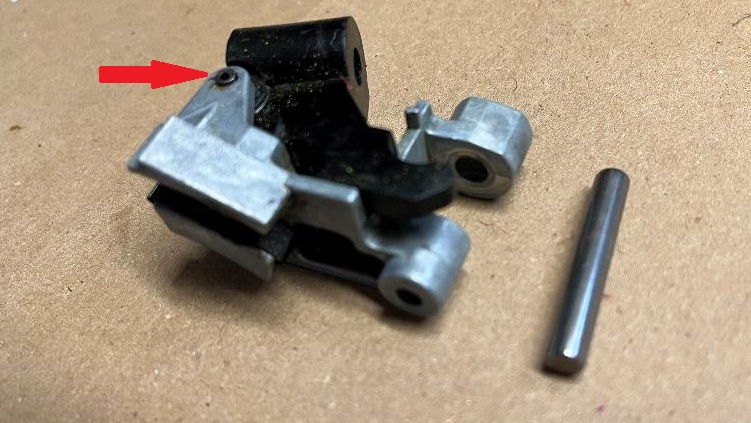
Figure 1. Repaired actuator and turn signal axis pin. Arrow shows where rolled pin had to be pressed into the opening and secured with Loctite Blue.
To get the turn signal housing mostly out (I was able to get by without taking it out completely, which would have required pulling the turn signal switch and its wiring harness completely out of the column) I had to remove everything in front of it on the column. This included the horn pad, steering wheel, horn contact/turn signal cancel cam, steering lock plate, turn signal switch and wiring, etc. Once the turn signal switch was out of the way I had to remove the ignition lock cylinder and disconnect the turn signal wiring harness on the lower part of the column. The latter provided enough slack to free up the turn signal housing to get it off the steering column but not completely remove it from the column and/or car. The 78 Factory Service Manual (FSM) and several YouTube videos I viewed did not adequately describe how to remove the turn signal actuator and particularly how to remove the lock cylinder from a car where the cylinder has not been previously removed. I spent many hours sitting in my car’s interior in a hot garage over a couple of days, revisiting the FSM and videos to figure out what exactly to do. My description of the process I eventually followed continues below.
Removing the Horn Pad, Steering Wheel and Lock Plate:
These steps are relatively straightforward and are well documented in the FSM and on You-tube. In summary, the horn pad is removed by taking out two screws on the back side of the steering wheel and disconnecting one electrical connector, for the horn. The car battery should also be disconnected at this point. Removing the steering wheel requires removing one large nut on the steering shaft then using a 2-bolt puller with two 7/16th inch/14-pitch bolts about 2.5 inches in length to pull it loose. Once the steering wheel is off, a plastic cover over the lock plate must be pried off with a screwdriver and a lock plate puller is required to depress the lock plate against a spring. This allows the “snap ring” that holds the lock plate on the shaft to be removed. After the snap ring is removed (see comment below about removing it) the lock plate, horn ring canceling cam, and spring below it can be removed, exposing the turn signal switch.
Steering wheel pullers and lock plate pullers are both available for rent at many parts houses. The details of the steps summarized above can be found elsewhere and are not repeated here. However, note that in my experience, removing the lock plate snap ring and later installing a new one to reassemble the steering column were the most tedious and time-consuming efforts on the repair. I have no suggestions on how to do it easier or faster!
Moving the Turn Signal Switch Out of the way:
Once the lock plate was out of the way I was able to proceed without completely removing the turn signal switch. Figure 2 shows a photo of the switch.
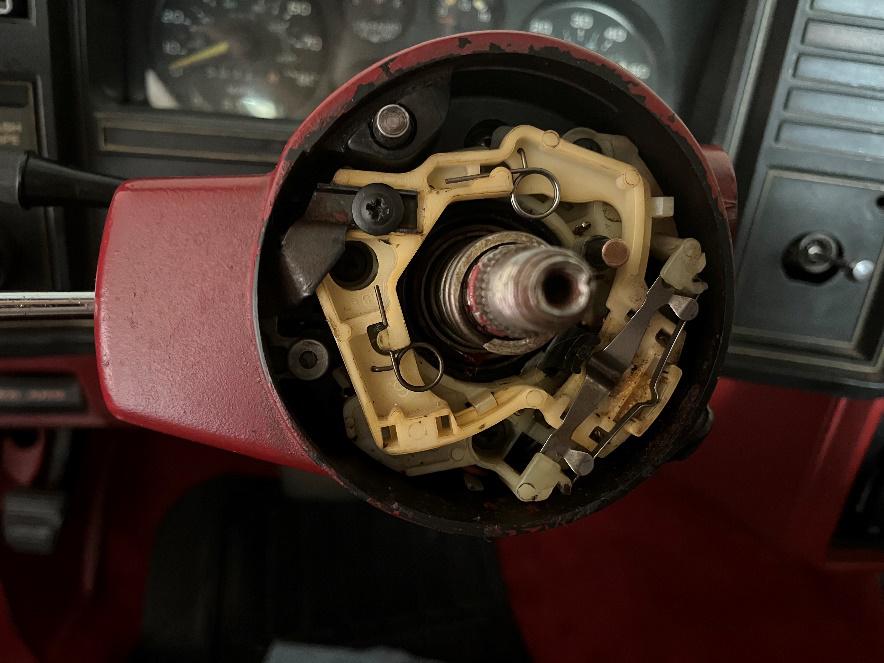
Figure 2. Steering column prior to removing turn signal switch.
The switch comes loose by removing three screws that fasten it to the interior of the turn signal housing, removing an arm that connects the switch to the turn signal actuator (one screw)1, and removing the hazard flasher knob from the right side of the turn signal housing (also one screw, but keep track of the screw, knob, housing and spring for reassembly). However, to get enough slack in the wiring I loosened the turn signal wiring connector from the bracket near the bottom of the steering column under the dash and separated the connector for the turn signal from the body wiring connector. This gained an inch or so of slack which was just enough to slide the turn signal housing off of the steering shaft and out of the way. The lower cover on the dashboard below the steering column must be removed to reach those connectors.
Removing the Turn Signal Housing – Lock Cylinder First:
This is where it gets more difficult. Once the turn signal switch is out of the way, the first step is to remove the ignition key lock cylinder, and I found the FSM and YouTube sources to be inadequate. The cylinder is removed by depressing a spring-held keeper on the cylinder body while pulling out on the cylinder from the key side; once the keeper is pressed down the cylinder can be pulled out of the housing to the right. Figure 3 shows the ignition lock cylinder and the arrow points to the keeper that must be depressed.
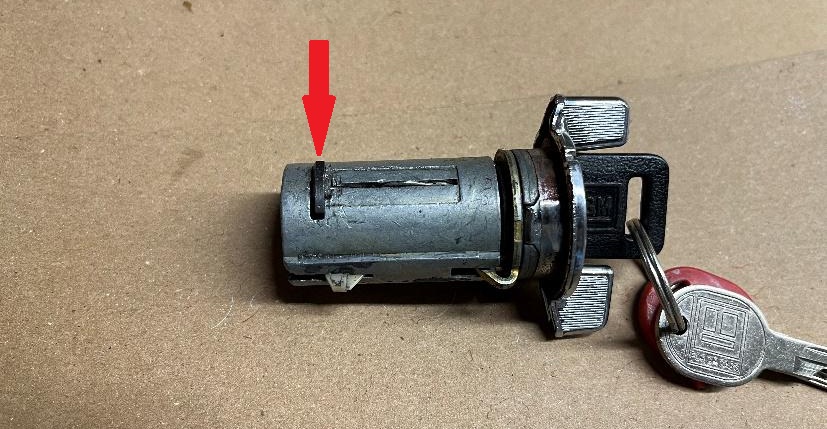
Figure 3. Ignition lock cylinder; keeper is near the left end of the cylinder and near the top in the photo (see arrow).
However, in a car that has not previously had the cylinder removed, the keeper cannot be seen or depressed because a thin layer of pot metal (called flashing in the FSM) covers the area over the keeper. This layer of pot metal lies between two thicker vertical ribs on the upper right side of the turn signal housing, to the left of the key (see Figure 4). A thin tool like a small screwdriver and light hammer are needed to break this flashing out to provide access to the keeper. The FSM says to stay to the upper right in this slot, but on my 47-yr-old El Camino the keeper was more to the upper left side. I cleared all the flashing I could out of that slot to provide full access to the keeper/release. Once the keeper is exposed, use a thin screwdriver or other instrument to push the keeper down and extract the cylinder by pulling to the right. Make a note of the key position when removing the lock cylinder (I used the Lock position) and be sure to re-insert in the same position later.
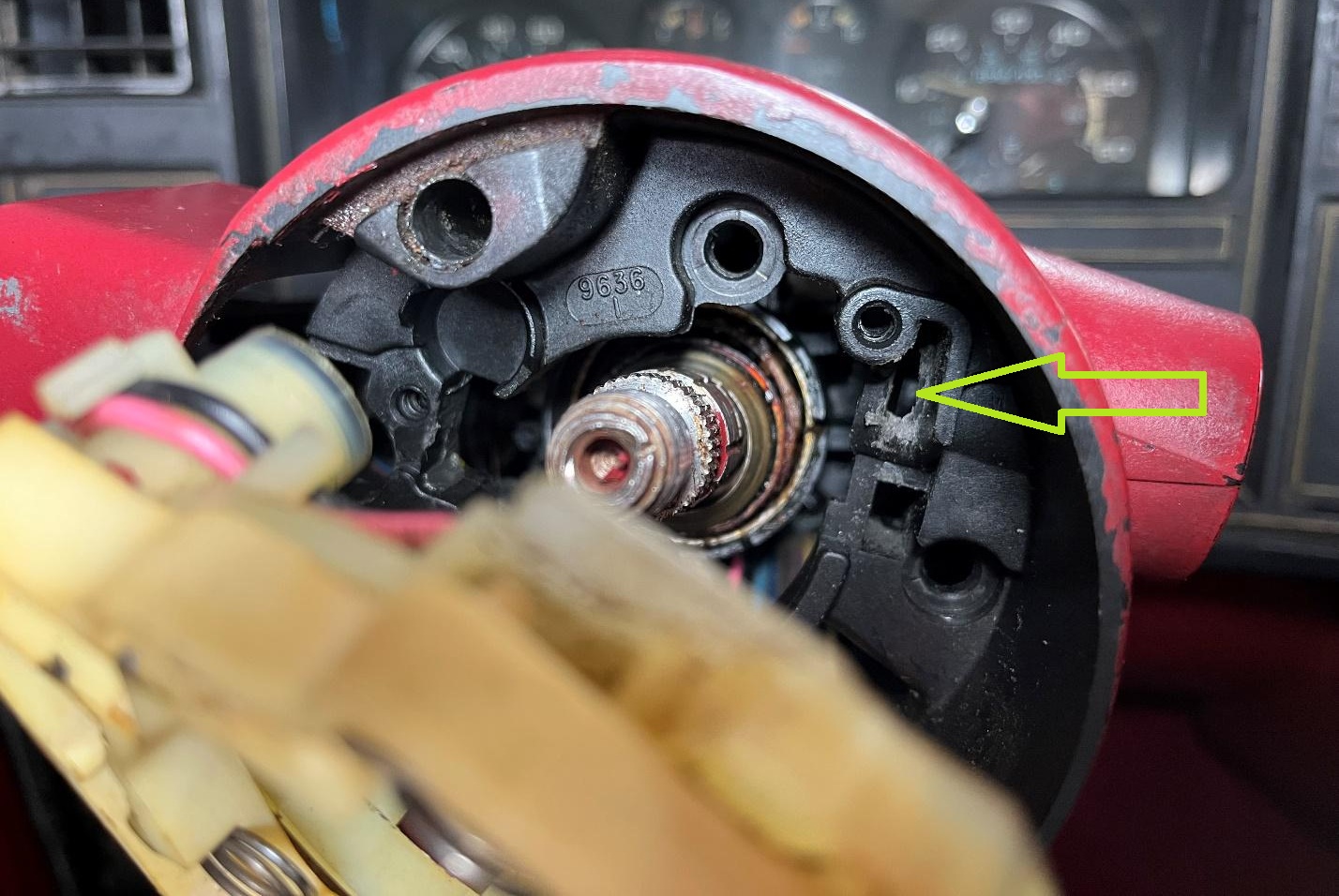
Figure 4. Location of the ignition key lock cylinder keeper, after removal of flashing (see arrow).
Removing the Turn Signal Housing:
As mentioned above, I did not completely remove the turn signal switch and thus could not completely remove the turn signal housing from the car, but I was able to remove, repair and reinstall the actuator. It is best to get the turn signal stalk and tilt wheel lever out of the way before trying to remove the housing.
The turn signal stalk is just pulled straight out, in a manner similar to removing a socket off a rachet wrench (see Figure 5). There is a little spring-loaded detent ball that holds the stalk in the actuator, but a firm tug on the stalk will overcome the detent and it will pull straight out. If the car has cruise control it will be best to just let the stalk dangle to avoid pulling out the cruise control wiring and having to feed it down the steering column later. The tilt wheel lever is threaded and just screws on and off. I used a small crescent wrench on a flat portion of the lever to loosen the lever then unscrew it by hand.
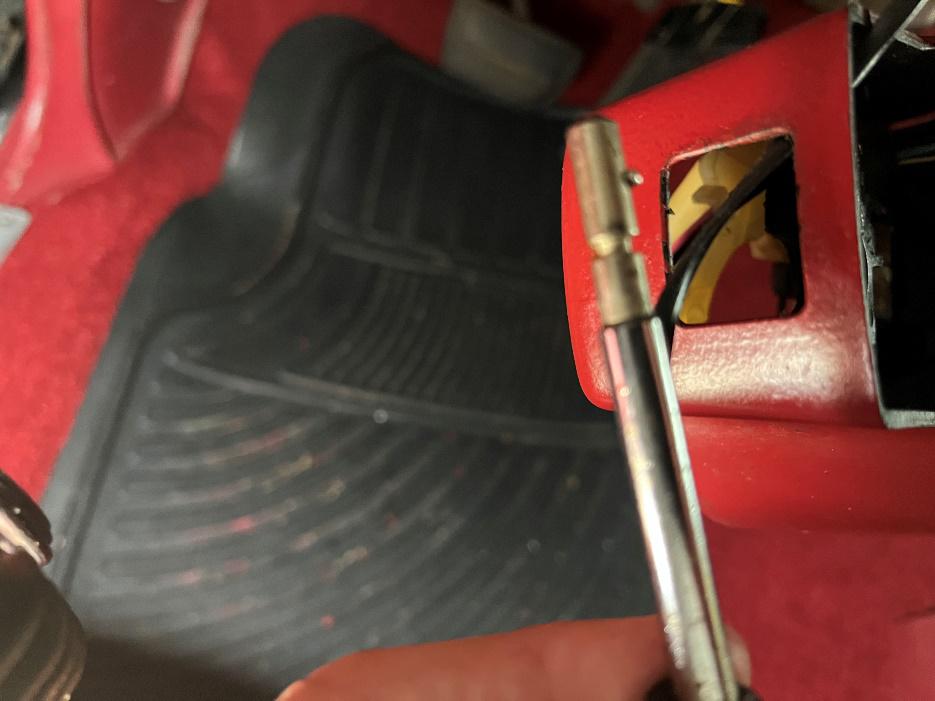
Figure 5. Turn signal/dimmer stalk after removal.
Next, remove the three large gold-colored screws that hold the housing in place (see Figure 6). Once these are off, the housing can be pulled toward you. It is a friction fit so it will need to be pulled and pried a bit to get it loose. The partial housing around the tilt wheel lever will probably remain in place when the main part of the housing is slid toward you. If that happens, an off-white plastic part that is part of the dimmer switch actuation will likely fall out. I describe how this is replaced when the housing is re-installed below, but it is best to pay attention to this and note how it is oriented as it falls out. I took me a while to figure out the orientation since I did not pay close enough attention as it fell out!
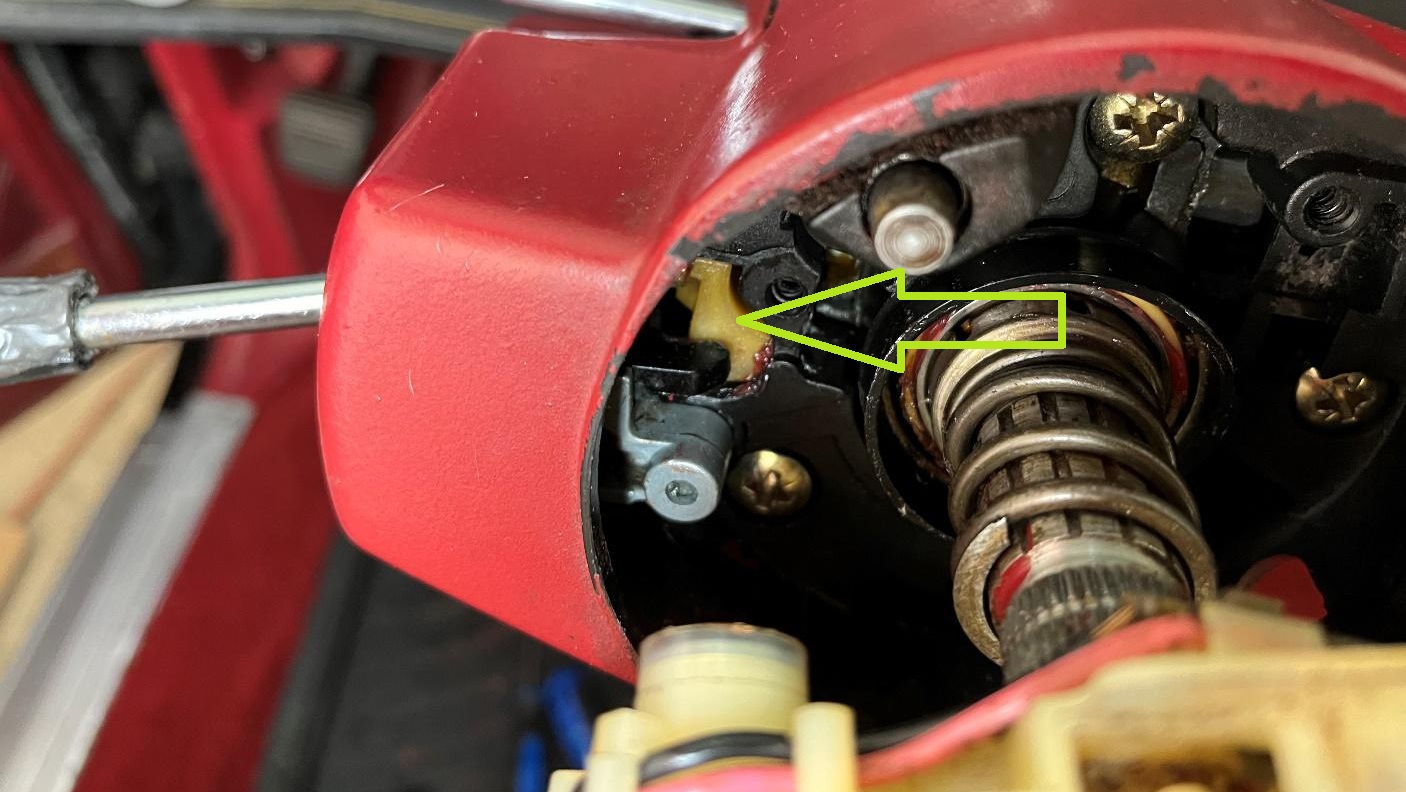
Figure 6. View of the three gold screws that must be removed to remove the turn signal housing. Arrow points to dimmer switch part that will likely fall out when separating the turn signal housing and tilt wheel level housing
Repairing or Replacing the Actuator:
Once I got the housing loose (but not completely removed) I was able to use a small drift pin to push the pin out that attaches the actuator to the housing (and provides the left/right turn signal pivot). (See Figure 1 above).
Once the actuator was out, I realigned the parts, specifically the vertical rolled pin axis (oriented vertically as installed, but providing the in/out motion to the dimmer switch linkage) and gently pressed the rolled pin back through the upper axis pivot point. I applied Loctite Blue thread locker at the upper pivot point to better hold the rolled pin in place and also used a sharp punch to slightly expand the upper end of the rolled pin to keep it in place.
Once that was completed, I reinstalled the actuator in the turn signal housing with the stainless steel pin and began reassembly.
Reassembly:
First, insert the off-white/light yellow dimmer switch link into the turn signal actuator (see Figure 6 for its orientation). That link has a handle-like appendage that points to the front of the car. The appendage has a slot through its middle, and at the other end has a J-shaped portion intended to push on the stiff wire that in turn presses the dimmer switch. The slot on the appendage engages into a tab on the inside of the tilt wheel lever housing. When it is all installed this off-white part makes the dimmer switch work by pressing on the stiff wire when the turn signal lever is pulled toward the driver. I used a little wheel bearing grease where the link goes into the turn signal actuator to help keep it in place during reassembly.
Once the off-white part is in place on the tab inside the tilt wheel cover, set the tilt wheel cover in the appropriate place on the upper left of the column, then push the turn signal housing into place while ensuring the turn signal stalk and cruise control wiring (if equipped) are out of harm’s way. Once pushing is not effective, start the three gold hued screws into the column and slowly work the housing into place. Be sure to keep the tilt wheel and turn signal housings aligned so they fit together tightly when the gold screws are tightened. Again, avoid pinching the cruise control wiring from the turn signal stalk, if so equipped.
Note that at this point I had decided to do away with the column key buzzer, so there are some small contacts that I removed and ignored here. You are on your own if you wish to maintain this annoyance!
When going back together, once the housing in place, reinstall the turn signal switch, and attach the arm that connects the switch to the turn signal actuator. Reinstall the turn signal lever and tilt wheel lever and confirm function of both. Also install the hazard flasher screw, housing spring and button.
Beyond this point the spring, horn contact/cancel cam and lock plate can be reinstalled, requiring the appropriate rented press tool and a new snap ring. As mentioned above, installing this snap ring could be tedious and time consuming. It also will likely require an online purchase to procure a reproduction of the no-longer-supported OEM snap ring part. Once the snap ring is in place, release the press to then install the lock plate cover, steering wheel, and horn cover.
Please Note: We would like to thank the author of this article Gary Blythe, for compiling, writing, and submitting this write-up.
My Experience:
When I bought my 1978 El Camino in May 2025, I found that it is equipped with the CD4 Intermittent Wipers. I replaced torn wiper blades and checked that the wipers operated and briefly tested the intermittent switch. I did not try the washer. The washer cover was missing, and I was not sure what the cover was supposed to look like. There were a lot of exposed parts in the washer area, such as relays, capacitors, resistors, solenoid, etc., which I assumed were part of the delay system, but otherwise had no idea what their functions were. Figure 1 is a photo of the washer assembly when I purchased the El Camino.
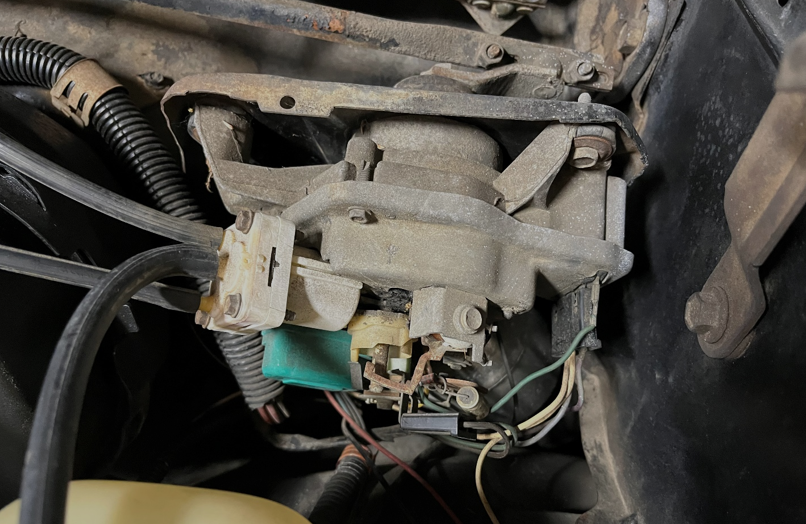
Figure 1. Wiper assembly when El Camino was purchased.
Seeking a replacement cover, I tried the “first design” and “second design” washer covers, but neither was deep enough to cover the extra parts for the pulse system. I finally found an eBay listing for a NOS washer assembly that was reported to fit a 78 El Camino with intermittent wipers. I bought that thinking all I wanted was the cover, but at least I would have spare washer parts, if needed. The cover part number is 4961228.
Before I started working on the washer and delay equipment, I purchased a used 1978 Fisher Body Service Manual on eBay for under $20, and it provided an in-depth discussion of the delay wipers and how associated equipment fits into the washer enclosure. Once I understood the operation of the pulse system and washer system, I could see that the solenoid used in my washer system was inoperative due to the electric connectors having been broken off, part of the “ratchet pawl” lever controlled by the solenoid had been bent out of the way (likely because the solenoid was not functional), and the washer pump body was not in good condition. Figure 2 shows the washer assembly as removed, with the original pulse relay and timing equipment still installed.
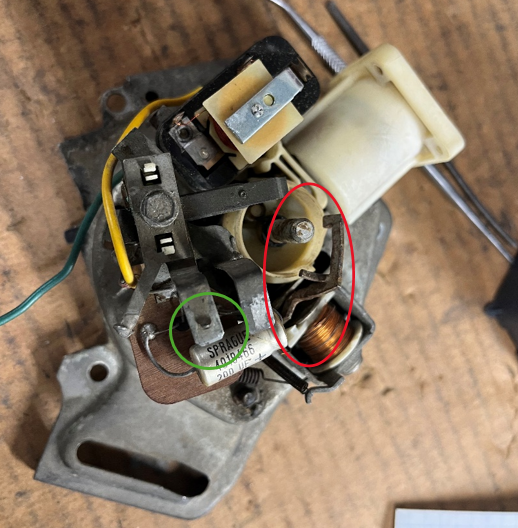
Figure 2. Washer assembly as removed, with missing cover. (Red oval outlines area where power connectors to solenoid are broken off and rachet pawl lever for washer cam is bent out of shape. Turquoise pulse relay cover has been removed in this photo (to left of vertical yellow wire). Green circle highlights the head of the one bolt that secures the pulse assembly to the washer chassis.)
At that point, it became apparent that the NOS washer pump assembly I purchased was exactly what I needed. In addition to the cover, it included NOS components of the washer such as the solenoid, levers, pump body, etc. that I also needed.
Now I had an old pump assembly that had the functional pulse components installed but a bad washer system, and a NOS washer assembly that had the washer components but none of the pulse assembly. After comparing the two “chassis” of the pump bodies, it was apparent that the NOS chassis had all the correct openings and holes that matched my old assembly with pulse parts installed. The question was: what would it take to move the old pulse components onto the NOS chassis? After considerable scrutiny it became apparent that the multiple pulse components were all connected as a single unit, which was held onto the chassis with one long self-tapping, small diameter hex-head bolt (see Figure 2).
After removing that bolt, the whole pulse assembly was removed and installed on the new chassis with the bolt cutting new threads. Two other adjacent holes in the original chassis were used as locating tabs for the assembly to keep it oriented correctly, and those holes were also in the new one. There are no electrical connectors between the washer and pulse wiper components. Figure 3 shows the old assembly with the pulse component removed and the new washer assembly with the existing pulse equipment mounted. The new cover is also shown unmounted. This combination of parts restored the functionality of my washer and intermittent functions. Figure 4 shows the NOS washer and cover as installed on my El Camino.
Note that the pulse wiper originally used a slightly different pump drive cam on the underside of the washer chassis. I left the non-pulse cam in service when I installed the washer pump chassis to the wiper motor assembly, and the washer appears to operate okay.
Takeaway for Others:
My experience only applies directly to 1978 and 1979 El Caminos (as well as Malibu and other A/G bodies). From my searches on the web, it appears that 80-83 models use a circuit board mounted in the pump assembly enclosure to provide the pulse delay controls rather than the analog devices used on my 78. I also see that what is used on my 78 might also apply to earlier models from 1976-77. My understanding is the 84 and later G bodies use a completely different wiper configuration.
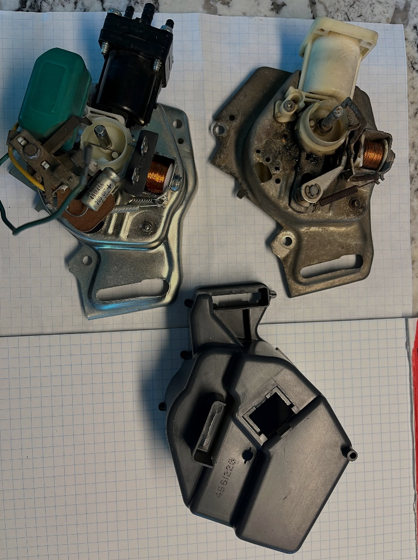
Figure 3. New washer assembly with pulse components installed on left, old assembly on right, and the new cover below. (cover is upside down compared to washer assemblies, and clear plastic cover over the rectangular opening near its center has been removed).
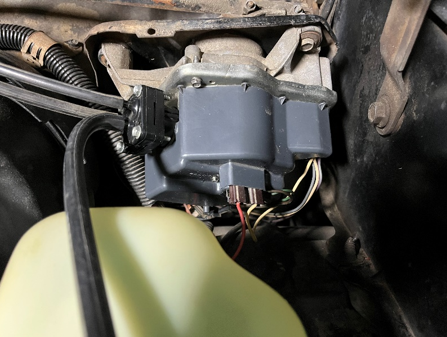
Figure 4. New washer chassis and cover as installed.
There are several online options for the 76-79 washer pump assembly with a cover, including used or NOS parts, and ThePartsPlace.com offers a reproduction version. For The Parts Place the listing says: “DOES NOT INCLUDE CIRCUIT BOARD, MUST RE-USE YOUR OLD ONE.” I assume this is directed at the 80-83 models that apparently were converted to use a solid-state circuit board controller. This reproduction might also be applicable to 78-79 models if the appropriate openings in the chassis are included in the reproduction to mount the 78-79 pulse relay and timing component assembly rather than the 80-83 circuit board. I do not know if that is the case. As far as refurbishing the 76-79 delay components, the pulse relay is still available from several sources for ~$20-$30. For the timing circuit, if individual components have failed, those could likely be replaced as needed with over-the-counter generic parts. The timing circuit includes a capacitor, two diodes, transistor, and a holding switch all located on the washer chassis. I recently found a NOS source for the entire pulse assembly for mounting in the washer body and the associated dash switch (see Figure 5 photo below) although the asking price was relatively high at ~$135. Entire windshield wiper motor and washer assemblies from 1976 to 1979 GM cars with intermittent/pulse wipers also show up on eBay could be an option for restoring pulse and washer operation on a 1978-79 El Camino.
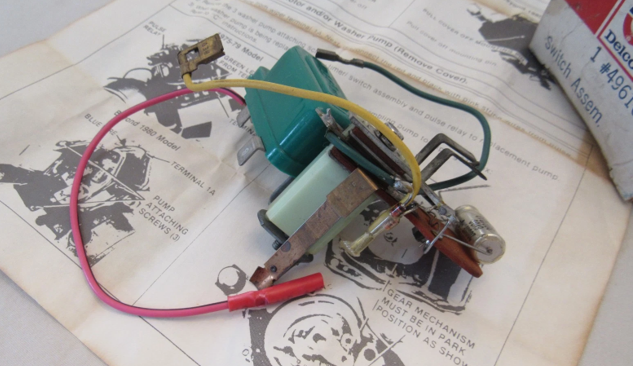
Figure 5. NOS 78-79 Pulse Wiper components for sale on eBay.
If you attempt to repair or refurbish the factory intermittent wiper and/or washer functionality on your 5th generation El Camino or other 1978-88 A/G body, I highly recommend that you seek and purchase a Fisher Body Service Manual for the year model of your vehicle. These systems are relatively complex, and the Fisher manual provides a great deal of illustrations, descriptions, wiring diagrams, troubleshooting decision flow diagrams, etc.
Our 1978 El Camino was born in Fremont, CA and lived in Florida for a good portion of its life. It has an all-original drivetrain down to the carburetor, albeit with maintenance done properly over the years, including a recent suspension rebuild to put it back to factory specification. It is probably the closest thing for a driving impression we can get for a true 1978 version in every-day use. We operate it, like all our vehicles, in all weather conditions and seasons. It has seen rain, snow, sun; pretty much most driving conditions. It has traveled up and down the eastern seaboard and lived for a year in the northeast with studded snow tires.
We have owned, currently own, and driven a LOT of 1970's and 1980's GM vehicles, as well as other domestic cars and trucks, in both restored and bad condition. We aren't specifically experts, but since not many people today have the opportunity to actually drive one of these in good condition we thought we should include this as a reference for anyone thinking of buying one in any condition.
First thing first: this is a GM vehicle from 1978. No, it is not as perfect as you remember it, memory being mostly fond reminiscince of things past and desired to be reclaimed. It drives and handles like a 1978 GM product. It cannot be compared to today's vehicles fairly. So keeping this in proper context, consider the other vehicles of 1978.
To be fair there has been one concession to power urges by a previous owner of this vehicle, that being the headers and custom dual exhaust. To also be fair, we doubt it adds little to any horsepower at all since this vehicle had minimal to no emissions equipment from the factory.
We own and daily-drive a lot of vehicles from this period, so given the general reviews on the internet we thought it best to write this honest review because this is frankly one of the favorites in our stable. It handles smoothly, drives nicely, and has the major convieniences like air conditioning and 6-way electic driver's seat. All factory.
Comfort: Our version has factory air conditioning, power driver's seat, and the roomy Malibu interior with dual center armrests and split bench seat. The optional full gauge cluster is still modern looking, accurate, and clear by today's standards. The interior is smooth and cleanly designed. Compare this to the GM truck line of the time with the blocky and upright interior. Sitting in a Suburban or GM truck from this time period for any length of time results in a numbness and uncomfortable experience. Sitting in our El Camino for long periods is no problem at all.
Styling: For the time period it was a very modern, sleek design. It is smooth and simple. We love the simplicity of it, and the overall balance of the style matches the nice even weight balance of the machine itself. The interior is as smoothly designed as the outside, and gives a roomy feeling that many other vehicles of this size lack even today.
Power: Our version is one of the rare factory 350 cubic inch V8 models with a three speed automatic. Contrary to what most say, these engines are not too smog-smothered being only available in 1978 and 1979. They do not compare well to today's powerhouses obviously, but they are smooth, strong, and durable. It was a fantastic engine for its time, and still holds up well today in everyday driving. It won't win any drag races, but after all these years it is still going strong unlike many over-complicated modern engines with too many moving parts. Our factory-issue Qaudrajet carburetor is well maintained and finely tuned, actually starting quicker and more reliably than our similar fuel-injected engines.
Hauling: With a rated bed load of 800 lbs and a tow rating of 5,000 lbs (as equipped), the El Camino in this format is comparable to the C-10 pickup of the same period. The stance and mirrors are actually well-suited to towing small trailers with good visibility. However the brakes show their limits quickly. For small loads this truck is actually preferred by our drivers over other trucks of the time period. Our version has the 350 LM1 engine, so it does tend to tow and haul better than most factory El Caminos of the period with its better low grunt power and torque.
Handling: The steering, although described by some modern reviewers looking back as 'numb' and 'horrible' is nothing of the sort. A properly maintained and adjusted steering box will not degrade to that point unless abused. We suspect that most reviewers drive worn out vehicles and attempt to compare them to factory vehicles. Our little truck handles cleanly and smoothly, especially given the comparable products of the time. Although some body roll exists, it corners and handles with very good weight balance.
Braking: This is one area that GM could have easily upgraded. Although suitable for many situations, the front discs and rear drums are just not well fitted for daily driving in today's world. When fully loaded or towing, the brakes especially show their limits. Brake fade happens quickly under load on hot days. This is fairly standard for all GM products of the day however.
Overall impressions: In the context of 1978, it is a very sleek, modern vehicle with good power and handling. Even in the context of today it holds its own and is quite acceptable for everyday driving in a modern world. As time goes on these are becoming more rare and recognizable by the general public, so if you drive one be prepared for comments and occasional admiration from other drivers. In addition to being a unique sector of the automotive market then and now, the practicality of these vehicles endures. It has the comfort of a car and the hauling capability of a small pickup. It has none of the disadvantages of huge, unmanuverable, over-powered modern pickups. It is easy and simple to maintain. Visibility is fantastic with the wrap-around glass everywhere. Perhaps one disadvantage would be its low ride height, with traffic views often obscured by modern behemoths on the road. To make it truly a well-hauling pickup, better brakes than the factory offered would be in order, however we prefer to keep this ride as factory as possible. If we need to move heavy loads we have other more suitable large trucks in our stable, as GM intended in 1978.
Related magazine reviews:
1978 GMC Diablo Magazine Review
1978 Malibu Magazine Review -- Car And Driver
Documents for model differences:
Chevrolet El Camino Model Charts
Chevrolet El Camino Emissions Designations
Chevrolet El Camino Powertrain Combinations
Chevrolet El Camino Body Information
General information:
Vehicle production numbers
These brochures and sales dealer specifications are useful for determining model year details:
1978 Chevrolet El Camino Sales Brochure
1978 Chevrolet El Camino Dealer Information
1978 GMC Caballero Dealer Information
1978 Chevrolet El Camino Wiring Schematics
1979 Chevrolet El Camino Dealer Information
1980 Chevrolet El Camino Dealer Information
1981 Chevrolet El Camino Dealer Information
1982 Chevrolet El Camino Dealer Information
1982 Chevrolet El Camino Brochure
1983 Chevrolet El Camino Dealer Information
1984 Chevrolet El Camino Dealer Information
1985 Chevrolet El Camino Dealer Information
1986 Chevrolet El Camino Dealer Information
1987 Chevrolet El Camino Dealer Information
Lock/Ignition Cylinder reference:
More print ads not shown on the rest of the page:
Example build sheets:
1981 GMC Caballero exported to Canada: